#advertising doesn’t work on me i need a show to be peer reviewed by the gay people on my phone.
Explore tagged Tumblr posts
Text
i know gotham knights cw was bad because we got on screen sapphic stephanie brown and misha collins harvey dent and none of the batgirlies on my dash said anything about it
#advertising doesn’t work on me i need a show to be peer reviewed by the gay people on my phone.#stephanie brown#two face#Batman#Batfam#dc
40 notes
·
View notes
Text
ok I wanted to clear my head before posting something about the wilds fandom's fiasco
I just think we need to take a step back and try to understand where people are coming from. so as a fan who really doesn't want to see boys in the show, I'll try to explain why it felt such a big deal for some of us.
1) "we knew all along boys would be involved. why is it a surprise for you all? it's literally the plot of the show":
we actually didn't know boys were involved before the very last seconds of episode 10. and even then, I personally thought it would be a footnote in season 2 or something. I watched the show because it was a girl ensemble (and I think a lot of us watched it for that reason), and because I was interested in their interpersonal relationships. I didn't go in thinking "oh nice! I hope they'll do a boy experiment next!". I really thought this story was about teenage girls and their trauma, and not young people in general. I mean, they marketed it this way. So we have reasons to feel feel disappointed when season 2 sounds like a whole different show, and is marketed like a whole different show too.
I really didn't care about the experiment part of the plot tbh... like... I thought it was incredibly dumb and I didn't buy it for a second and I think the show could have stood on its own without the whole experiment. This is also why I don't see the need to add men, especially if the argument is "but Gretchen needs a control group!". Gretchen doesn't need anything because she's dumb and her experiment has 0 scientific value. You want to talk sociology? because I'd love to! What Gretchen needs is some ethics for starters. She also needs to be peer reviewed, something she obviously doesn't care to. Gretchen most of all needs fucking quantitative data please!!!! taking 8 random american girls to prove... whatever she wants to prove is the dumbest thing I've seen in YEARS. Finally, if Gretchen really needs a control group, then it's not a boy control group. It's 8 troubled girls of the same age / same origins staying at home in their environement, to see how they fare within a patriarchal society. It's 8 non-traumatized girls on an island, it's 8 boys and girls together at home or on an island, it's 8 girls in therapy, and it's also 8 trans girls and trans guys. Adding boys was a choice, not an obligation, and I don't think it will make the plot better, especially if it's at the expanse of the girls' screetime.
2) "the fans who don't want to see boys are as bad as Gretchen":
I don't want to see boys on that show because men are already everywhere and I'm scared they will take the girls' screentime. I wouldn't care if we didn't live in a patriarchal society with a 50/50 ratio of screentime all the time. Sadly, that's not the case so I'm kinda bitter that the attention will be stolen from the girls story, especially after it was advertised this way.
If the fandom really "hated men" like some of you implied, then we would have hated on the several men who are in the show already. I've never seen any hate directed towards Quinn, Ian, Alex, Thom and even Young. Faber, Jeff and Dave Goodkind are another story but the hate is well deserved.
So yeah, I don't know how expressing disappointment seeing a girl-centric show slowly becoming not girl-centric is the same as Gretchen, literally putting 8 girls through severe trauma AND physical danger to prove that women are better than men... I'm kinda confused
3) "the fans who don't want to see boys are hurting the actors' feelings":
I want to clarify that I'm not talking about hate directed towards the actors. I personally haven't seen anyone do it, but in any case, it isn't ok.
That being said, I really hope that those actors know how to separate criticism towards a show / their characters and criticism towards them personally. There's nothing personal about not wanting boys on this show lmao! I don't even know who the actors are and I don't care tbh. It's a job, like they're paid to do what's on the script, they have no leverage about what's written or not written.
Like... look at it this way: my job is to write bills and draft legislative texts. And it's political, of course, and a lot of people have a lot to say about those texts, more often than not, bad things. But I don't take it personally!! I didn't take the decision of passing the bill, I'm just here to follow orders and do what people above me tell me to do. and when people have valid criticism, I listen and I think about it because critical thinking is important and you shouldn't always do what you're told to do! like I can't do anything about it if I don't wanna lose my job, but I can at least know it's not ok.
we're not angry at the actors. we're angry at Amazon / possibly the writers depending on the artistic freedom they have. Thinking the actors are sad because we don't want men is as ludicrous for me as feeling sad because people didn't like the bill I worked on. It's nice when you work on something you agree with, but the decisions isn't yours anyway...
I'm honestly happy for the people who are excited about the boys. I mean good for you! But you can try to understand why so many of us are feeling down about this news. It's called empathy, what I believe this show is fundamentally about. The insane plot is just the coating. The best part of the cake is the girls caring about each other. Maybe we could try applying that to ourselves?
#the wilds#and if you don't want to see negativity. which I can understand. there's a block button and a filter system#mine
86 notes
·
View notes
Text
Dimension Jumping Pt. 5
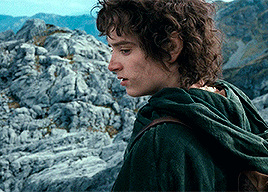
Comforting a grieving hobbit and time get everyone ready to go out!
Via the genius idea from katzrfsoa / Kat88
There's been mention of the reader not wanting to take the groups out, for fear of the public's reaction... so what about a cosplay convention? it would give the Reader the perfect excuse to allow them out, and they would wear their original clothes
----
This morning has been uneventful for the most part.
Breakfast passed by without issue and now everyone is off doing their own things.
You looked outside and took a peek in the guest room, but you still can't find him.
Sam, Merry, and Pippin are playing a board game you showed them; Legolas is doing his meditation sleep thing; Boromir and Aragorn are discussing something; and Gimli is stacking bread on Legolas' leg to see how long it takes until he notices.
Frodo, however, is missing at the moment.
Right as you were considering telling the others of his disappearance, however, you heard some shuffling from your hall closet.
You open the door carefully and take peer inside, not wanting to startle the small hobbit, and at first you don't see him.
There's more shuffling and you hear a quiet sniff, followed by soft sobs, and you then realize he's hiding behind the shelf.
The door makes a soft clicking sound when you close it, and right away the quiet cries cease. You didn't want to alert him with the door, you wanted to do it yourself, but it's too late now, so you just go with it.
"Frodo?" You call in a gentle voice, staying by the door incase he wants you to go.
"Y-Yes?' He calls back, not moving from his spot.
His voice is thick with emotion, and the sadness in his tone makes your heart ache painfully. And when you walk closer and see him huddled up behind the shelf, your heart breaks a little for him.
He hastily rids his cheeks of any evidence of his sorrows, though the puffiness around his eyes and constant sniffles don't much help his cause, and looks at you with a false smile.
"Frodo, why are you crying?" You ask with furrowed eyebrows, kneeling down in front of him so you may look at him at eye level (mostly).
"It's nothing." He tells you quickly, looking away from your compassionate face with the same sad frown on his lips.
When you don't move to get up or leave, his gaze slides back over to you and he realizes that you're not going to leave unless he straight up tells you to go away. This makes him sigh, but truthfully, he doesn't want you to go away. Not really. For having company in a time of sorrow always mends suffering.
"I... did not have a proper time to mourn Gandalf. I've been so caught up in the oddity that is this place that I almost forgot my sorrows altogether, but then this morning is all... came rushing back." He explains with a surprisingly even voice.
While he speaks you cross your legs and listen along intently, your hands folded neatly in your lap. When he finishes, you reach forward and place your hand atop his with a gentle touch, "I didn't know him, but I can tell he was very dear to you. Honestly, I can't offer much advice, but I can tell you that keeping it all bottled up inside is not a good idea."
He looks at you with that sad face when you speak, and it prompts you to continue, "Also, I know everyone else can be pretty overwhelming or they just don't understand, and I want you to know that I'm always here to listen if you're feeling down, okay?"
Your words draw a small smile from the grieving hobbit and it elicits a similar grin from you.
"Thank you, Y/N. I... actually do feel a little better."
"I'm glad."
---
After your discussion with Frodo you rejoin everyone back out in the main room and let him recollect himself, going right onto your laptop to get some work done.
You're idly scrolling through a scholarly article you need to research when you see it.
An advertisement for some sort of comic book, cosplay, convention... thing in the area (no wonder you've been seeing so many oddly dressed people recently).
At first you almost scroll past it, but then you get hit with the brick of knowledge and a lightbulb goes off in your head.
"Yes!" You scream, successfully scaring everyone in the room and Penny who is sitting with you for once. "Ohh, my god. This is freaking perfect!" You exclaim, clicking on the link to get some more information.
Your eyes practically soak up everything on the information page, and, once you've skimmed through all of it, you look up with a bright smile on your face.
Literally all of them are looking at you like you've grown two heads, but you only clap your hands together a few times. "Guys, I just had a huge brain moment!"
The joke goes over their heads as per usual, but you don't let that deter you.
"Huge brain moment?" Pippin asks in confusion, looking at his cousin like he thinks he heard it wrong or something.
"Yes! I've figured out a way to take everyone out!"
That certainly gets their attention.
"You have?" Sam asks exuberantly, dropping his game piece so he can turn towards you and pay perfect attention.
"I have, yes," you start, continuing once you're 100% sure they're all paying attention, "So here's the thing, I knew that I could take out you tall boi's without issue besides having to find a hat for Legolas here, and I could explain that Gimli here has dwarfism," you pause at that and realize it may be offensive to him, but you continue once more, "but I also knew that there's no way I can explain away the hobbits, and then I found this gem."
You turn the computer so it faces all of them, but they only look more confused.
"There's a convention thing in town for the next week, and it's the perfect opportunity for me to bring everyone out! We just have to dress up the hobbits a bit and pretend that they're children."
At your explanation you receive multiple pleased smiles, and it serves to make you feel even better about your idea. "And you can all wear your normal clothes, too. And if someone asks who you are... I'll figure out a game or something you guys can use as an alias."
"Are you sure that will work?" Aragorn asks with furrowed eyebrows, sitting up from his spot in your arm chair.
"Um, like, maybe 98%." You confirm with a shrug, "It's better than 88% though."
He doesn't seem like he disagrees with you, so you look back at your laptop again and start to look for ideas to make them more believable as humans.
---
3 hours of research later, and you've successfully compiled a completely fool proof plan to smuggle this merry band of bizarre boys out of your house.
What you've decided is that you'll put some makeup over Legolas' pointy ears to make them look more fake since the concept of elves is not lost in this world. Boromir and Aragorn can go as themselves, and you'll put some makeup on the hobbits much like you will Legolas (they'll be children elves since there are no hobbits in your world) and tell everyone who asks how they look so good that you're a professional makeup artist.
Gimli, fortunately for you, was the easiest to come up with something for next to the other two humans of this group. You can just tell people he has dwarfism and that's why he chose to go as a dwarf character.
Everything is in order except for what you're going to do, though you suppose you should match their theme and be some sort of renaissance, maiden, lady, thing. You'll figure it out, though you do need to make sure it's convincing like theirs.
You decided to, instead of putting it off, go ahead and start working on finding a costume to match theirs.
A couple of searches later and you come across a really pretty dress that looks to fit their style, and when you show it to them they give you the thumbs up, so you order it with express shipping so it should arrive tomorrow.
It's a lovely flowy medieval dress *just look up flowy medieval dress and go to images, there are some good examples there*, and you feel excited just looking at it. Of course, there's no guarantee that it'll be the best quality, but it's got great reviews and you certainly paid a hefty sum for it.
After that's done with you head to your bathroom to see what makeup you've got, and you find that you don't really have any theatrical/special effects makeup. You're going to need skin colored wax makeup, powders, and contour stuff.
You're no makeup artist, obviously, but luckily for you, your goal is to make them look less realistic, so it should be easy enough.
It's surprisingly easy to figure out what you need to make them as convincing as possible, and pretty soon you've got a nice little list going on that outlines each thing you need.
Since you don't want to delay anymore, you head out of your bathroom and grab your bag while putting on your shoes, "Legolas, I'm leaving now if you wanna come with." You suggest since he stated his desire to join you in the one of the last chapters (:o).
When you call his name he looks over at you quickly, smiling a bit at your offer, "Yes, but you said I need a hat."
"Oh yeah! I have one, just gimme a sec." You tell him, walking over to a drawer.
When you open said drawer, you find a grey beanie with ease and toss it over to him, "Here ya go. Make sure it covers your ears... and uh, tuck your hair up into it too if you don't mind."
He does as you say with ease and, surprisingly, he looks just as good with shorter hair as he does longer hair.
It sticks kinda awkwardly at first, so you waltz on over and gesture for him to crouch down so you don't have to reach up.
Once again he does as you request and leans down so you may fix it.
You adjust it a bit to make sure it won't fall first, and then you smooth it back a bit so it'll also look stylish. And once you're done you take a step back and smile at him brightly.
"All done! Let's go!"
---
He seemed rather fascinated in the way your car works first and foremost, but once you got him to look out his window instead of watching you, his excitement quickly turned into awe.
When you both get to the ULTA store he follows you without hesitation and asks some hushed questions about things he sees, like the light up signs, other passing cars, stoplights, and some other things.
You, of course, answer each question happily and lead him inside, holding the door open for him while he enters and looks around the brightly lit up makeup store.
Right away you head towards the general direction of the nose and scar wax (it's multi purpose, don't judge me), forgetting to make sure that Legolas follows you.
When it does occur to you, however, that the blond elf didn't come after you, you panic.
You turn in a circle and only stop when you see him standing with some ladies who practically have hearts in their eyes.
Unconsciously you breathe a sigh of relief and head over with the wax in your little basket, immediately reaching up to wrap your arm around his, "I got the first thing on my list, come on."
The girls stop their giggles and flirting as soon as you show up and look genuinely surprised.
You give them a smile and nod in acknowledgement, not wanting to make them feel bad over something so silly before turning with your arm still around his own and walking him over to look at some contour stuff and other things.
They make some snide comments when you turn your back about you being a 'clingy girlfriend' and 'not pretty enough to be with a model like that', but you only ignore it and relish in the fact that you didn't make them feel bad over something as silly as a cute guy in a makeup store.
"Why are those women talking about you like that?" He asks in a whisper, leaning down so only you will hear his question.
You look up at him with a bit or surprise since you didn't expect him to pick up on that, before you smile, "They're attracted to you, and they think that I was being selfish with taking you away from their advances."
"Selfish? Advances?" He looks confused, but you only smile and turn back to the display case.
"Don't worry your pretty little head over it, Leggy my boy."
"Leggy?" He asks slowly, looking at you in confusion.
"Leggy." You confirm with a nod with a distracted hum.
It isn't much later that you have everything you need, and so you go to the checkout and buy everything.
"Going to the convention?" The girl at the counter asks with a smile.
You smile back and nod your head, glancing up at Legolas before looking back at her, "That obvious?"
"No of course not, just the items in your basket always fly off the shelves around convention time." She replies with a giggle, ringing up all your items.
"Well, that's fair." You muse, putting your card into the reader to pay for it.
Once everything is in order she hands you your receipt and adds, "Maybe I'll see you there."
"Maybe!" You chirp back happily, liking the nice conversation going on here.
"You and your boyfriend have a good day now!"
You elect to ignore that.
---
On the way home you pretend to not notice the black car following yours and make small talk with the elf, answering some more of his questions and speaking idly on different things.
"There are so many odd, interesting things here..." He comments after a while, glancing out the back window. "Are you aware that, that car has been following us for the past 10 minutes?"
You nod and hum as an answer, "Mmhm, it's just Brian. He's probably trying to figure out who you are."
The blond knits his eyebrows together and glances back to look at the car again, "Should I do something about it?"
"The only thing you can do is ignore it. He went from lowercase 's' stalker to uppercase 's' since you guys arrived, and it'll only get worse if you intervene." You mumble, trying not to look in the rearview mirror at him. "It's fine."
"You don't seem to think it's fine." He challenges in the same even tone, turning in his seat towards you.
Instead of answering his question you look at him while you stop at a light and grumble, "I told you to put your seatbelt on."
"It's uncomfortable."
"I don't care."
"I will be fine."
"Not if we get into a crash, you won't."
The two of you stare each other down before he slowly reaches up and buckles his belt, never breaking eye-contact.
"Good boy." You coo in a way-too sweet voice.
"Anyways, I know we said as much before, but you needn't worry about that man while we're here." He continues despite your obvious subject change.
"I know." Your reply is softer and less defensive this time, for you really do appreciate it, "Thank you."
He looks surprised at your sudden gratitude, and his expression shows as much "For what?"
"For being you. For looking out for me. All of you."
This time he smiles and says no more.
---
When you both get back to your house you immediately put everything in your bathroom and get onto your laptop to view some techniques on theatrical and movie makeup, Pippin and Merry on either side of you while they view through the pictures and videos with you.
"That one looks interesting." Merry pipes up suddenly, pointing at a person to wolf makeup transformation.
"Yep, and way past anything I can do."
This pattern of going through pictures and viewing clips goes on for a little while until they two hobbits depart to have lunch, meanwhile you continue on so that tomorrow will be a success.
You're both excited and nervous at the same time, wanting to see how it'll all turn out but also dreading it incase something goes wrong.
You know the most important thing is to have a positive mindset about it, but it's kinda hard sometimes during your more anxious moments.
Also, there's the issue of Brian possibly following all of you...
Nah, that'll be a problem to think on for tomorrow.
"What time will we leave tomorrow?" Aragorn asks from his usual spot on the rocking chair, Penny still nestled in his lap as per usual.
"Around the morning. I bought the tickets already so we won't have to stand in line for too long... Hopefully."
"Thank you for working so hard so that we may see more of your world." He comments suddenly, stroking his hand down her fluffy back.
You tilt your head to the side and smile a bit, "You don't have to thank me."
"No, I do. You have seen to our every need and we no doubt pose to be a huge burden. Thank you, really."
His words make you flush slightly, and you look away shyly.
You've grown to care about all of them, so of course you would do anything to keep them comfortable at this point. More than anything you're just glad they see how much you're trying to make things easy on them. It feels nice being recognized for your efforts.
Plus, the added protection from Brian is pretty sweet.
"Anything for you guys."
#the fellowship x reader#the fellowship of the ring#the fellowship of the ring x reader#frodo baggins#pippin took#boromir#lotr gimli#legolas greenleaf#samwise gamgee#merry brandybuck#aragorn#lord of the rings fanfiction#dimension jumping pt. 5#dimension jumping pt. 2#frodo x reader
169 notes
·
View notes
Text
No, Alina Isn’t Crazy
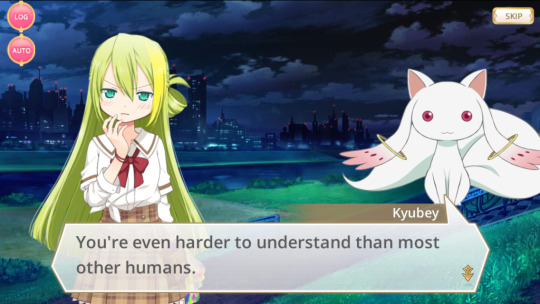
Let me explain...
When Alina was first introduced, I thought she was the character that made the least sense as an actual person rather than as a trope-y “mad artist” archetype. But after the reveal of her backstory, I find her personality and motivations do make sense, especially when you consider the events of Alina’s Magical Girl Story from her perspective.
Indeed, since that story’s release on JP, she’s quickly risen to become my favorite new character from Magia Record. Hence why I’m posting this today - it’s another semi-Magia Rapport related post, haha. Alina is definitely my favorite of the Forest element characters, and perhaps this essay will show a little of why that is.
Provocative title and Magia Rapport aside, though, what’s actually below the "Keep reading” is a close read analysis essay, specifically focused on Alina’s MGS. (A lot of Holy Alina’s MGS serves to confirm and reinforce little points scattered throughout this too, but this post was long enough without it!)
Introduction
The theme of Alina’s own art might be “Alina’s beauty” and “life, death, and emotion/decay.” But I would argue that the theme of her MGS as a when taken as a short story is “voyeurism and objectification at the cost of self-identity.” Specifically, how Alina’s actions and personality are the logical conclusion to that concept taken to an extreme.
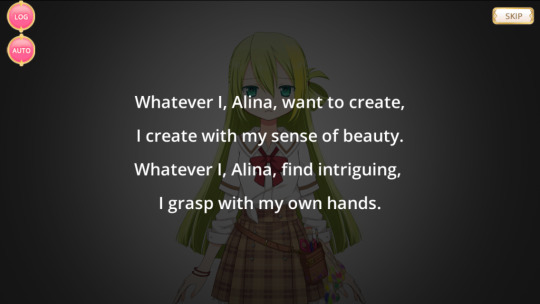
There’s one important truth to Alina’s world, and that is the idea that Alina’s art IS Alina. We see it at the start – when she says her art is what she enjoys and what she grasps with her own hands. We see it at the end – with her realization that her art’s theme is “Alina’s beauty.”
And at the end of the day, what MGS Alina most seems to want is to be left alone to do art, to be herself. But who is Alina?
Alina the Teen Prodigy
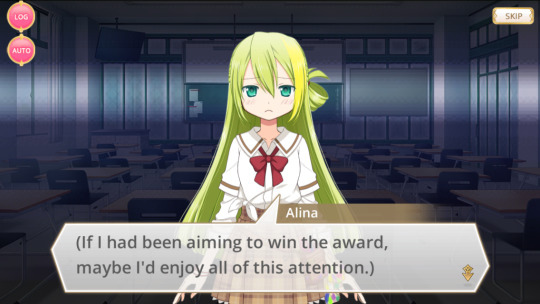
Unfortunately for Alina, her fame gets in the way of figuring that out. Such is the life of a teen prodigy. As perhaps can be expected, constantly parading children under a spotlight is a great recipe for turning out extremely high-strung kids with very warped self-esteem.
(See also: Nemu, but especially Touka.)
The exchange regarding the award here is a good illustration of that mindset. It might initially seem contradictory for Alina to work desperately hard to win an award that she later doesn’t want and claims she wasn’t aiming to win. But once being “gifted” becomes central to your identity, winning an award doesn’t feel good anymore. It feels more like running in place, just the bare minimum expected of you to maintain your identity as a genius. And Alina’s perfectionism means she can’t not hold herself to that standard.

Indeed, Alina is already showing signs that she’s struggling under the pressure and overexposure. Normally, Alina seems to love talking about art and her own works (as long as it isn’t about herself, anyway). Arguing with her teacher and running away are far more of a bother and interfere with her ability to get back to painting far more than a quick meeting would have been. Yet she curses at her teacher, bolts, and skips school rather than have to deal with the consequences of her fame again.
She’s irrationally lashing out, asserting her boundaries in whatever way she can. And with the way the characters react, this doesn’t even seem like the first time it’s happened, either...
Which suggests Alina’s problems with her fame also aren’t new. When we first meet her, Alina is already a lot closer to a breakdown than she appears on the surface.

Having natural talent from an early age, Alina probably hasn’t learned how to deal with failure without spiraling into a full blown identity crisis. As a perfectionist, she’s also hypersensitive to even the slightest mistake. And given that she’s been famous for a few years at this point, her acting out is practically expected.
Just given the setting that she’s a well-known child prodigy, it’s not surprising that Alina has all these traits.
Alina’s Adults Are Useless
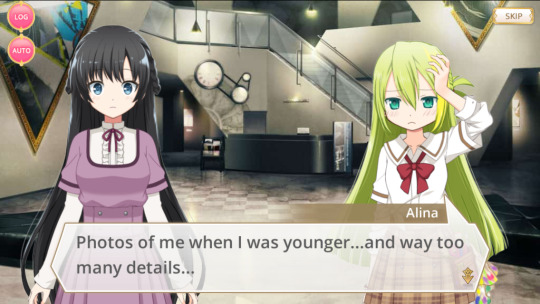
What is a bit disturbing, though, is that adults around Alina aren’t any help in protecting her from her fame.
Indeed, from what we see, the pattern is the opposite - over and over, the supposedly “responsible” adults in Alina’s life say her visibility matters more than her consent. Her teacher pressures her into competitions she dislikes and then gets on her case when she pushes back. Her parents put up her whole life story, including photos of her as a kid, without Alina’s approval or even permission.

Jumping ahead, I think it’s rather telling that Alina manages to destroy all her art, commit suicide, and get rescued by a third party – and none of these adults even visit her. A popular theory is that Alina’s parents are travelling in a different country. But - did no one tell them? Did they not care? As it is, anything Alina does – even blatant red flags like destroying a classroom and her own art – is treated as just another work of artistic genius, to be advertised and exhibited.
(Because apparently nothing says High Art like creep shots of a teenage girl having a mental breakdown.)
Of course, Alina isn’t being neglected or abused like Sana or Yuma. Not even close. But she’s not in a great situation either. She doesn’t really have anyone she can turn to in a crisis. The adults in her life mostly use her for their own ends, reinforcing that her worth is in her fame as an artist, not her value as a person.
Alina’s Peers Aren’t Much Better
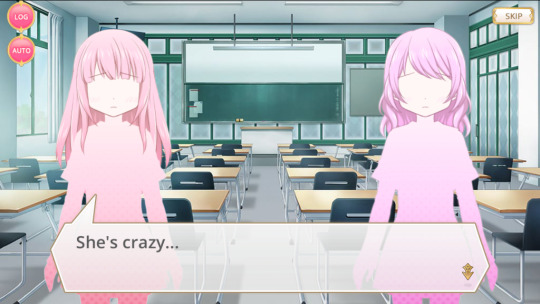

Then, on a more subtle level, there are Alina’s peers. Whenever she’s mentioned by people her own age, she’s either the subject of scary rumors or glowing admiration. Other kids know her as a celebrity name to be idolized or feared, not a person.
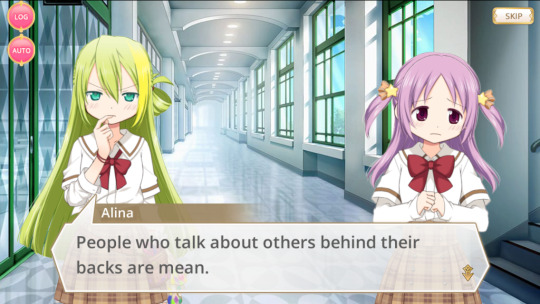
Before becoming a magical girl, the only person who actually makes an effort to befriend Alina is Karin. But even she is initially caught up in the aura of Alina’s fame and contributes to the swirl of gossip around her.
The result is a situation where everyone around Alina has their own opinion on who she is. No one seems to care or leave space for who Alina wants herself to be. And Alina, not having a social life to fall back on, is increasingly left with “genius artist” as the only means she has to interact with the world. It’s a self-reinforcing spiral.
The Critic’s Letter


First, what it’s not: this isn’t about Alina getting a bad review and not being able to handle criticism of her work. She’s already won the competition. And Alina is perfectionistic to unhealthy levels - she’s already her own worst critic.
Rather, the letter’s insinuations are both subtler and crueler. As Alina says, the critic isn’t concerned with her artwork - he’s commenting on Alina as a person. Thus, the critic’s words are the same pattern as before, now crystallized into its sharpest and purest form.
Alina’s internal sense of identity is precariously fragile. Meanwhile, Alina’s external identity is being used as a canvas for other people’s desires. Even though all Alina really wants is to create art for her own sake, other people obsess over and dump their own meaning (or lack of meaning) onto her works.
Once again, Alina’s art is conflated with Alina herself. The person is being evaluated as a piece of art.

As if that wasn’t enough, the letter’s final insinuation that Alina is losing her brilliance is a triple threat. If she can’t create great art, Alina loses the activity she enjoys most. She also loses the one thing she knows other people value her for. And worst of all, she loses the only touchpoint she has for her sense of self.
Cue existential crisis. Alina’s life is Alina’s art. Alina’s art is Alina life. Without one, she doesn’t have any concept of the other.
And in the light of all this, her suicide makes perfect sense.
Alina’s Suicide

Welcome to the literal and figurative objectification of Alina. Literal, in that she’s turning into a corpse. Figurative in that by putting her body up for display, she’s allowing people to voyeuristically consume it – an idea further reinforced by the “Kusouzu / Nine Phases” reference in the title implying a tinge of sexual objectification as well.
Now that she’s destroyed all of her previous works, the only thing Alina leaves her audience to look at is Alina herself. Filming her body as it turns from a person into a dead object was simply the logical conclusion to a life of being displayed, objectified, and overwritten by others’ perceptions.
But how does Alina feel about this ending?

The day of her suicide, Alina rushes around in a kind of manic euphoria. This isn’t especially odd. After all, it’s not uncommon for a suicidal person to outwardly appear happier before they make an attempt, as finally having a concrete plan of action can feel like a huge relief.
Dying means a solution to Alina’s worries about her talent fading. Dying also means an end to all the pressure, all the constant struggle of performing to ever-heightening expectations. Alina can simply abandon the cases and tools once she’s done with them - no need to stress about the future when she won’t have one.

Alina’s farewell, though, betrays darker emotions. It’s simultaneously deeply spiteful - “this is what you all wanted from me, are you happy now?” - yet also an admission of utter defeat. Alina is giving up her very humanity and selfhood to be evaluated as whatever her audience wants.
Throughout the story, everyone keeps telling Alina that her art is intoxicating, pulling the viewer into it… but the reality is the exact opposite. Alina’s art was just something Alina made for herself, and any intoxicating meaning was something the viewer injected into it.

And thus, Alina’s revelation. Alina’s theme is “Alina’s beauty” – both a rejection and an embrace of that objectification. Now, Alina has declared that her art loudly and unabashedly about herself, viewer projection be damned. And yet, at the same time, since “Alina” is what viewers are obsessed with seeing, then Alina will give them exactly what they want…
An Artistic Failure?

So then why does Alina consider her final art to be a failure? It fits well within the theme of “Alina’s beauty.” Indeed, her later works like “Humanity’s Implicit Reward” and even her swimsuit are arguably just softer variations of the “Alina’s body as forbidden yet alluring object for the viewer to consume” idea that is present here.
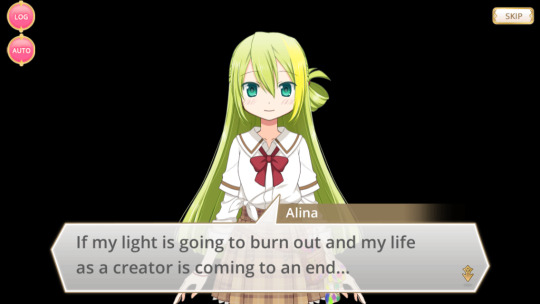
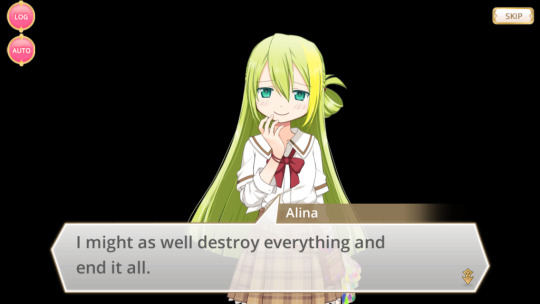
This suicide also seems to fit into the “life and death” motifs she has. It’s a twisted kind of resurrection - effectively, she’s killing herself as a human in order to live on eternally as a memorable piece of art.
Alina plans her final work directly because she thinks she’s dying as a creator. Rather than face her brilliance fading, she chooses to defy it by going out in a blaze of glory. And when put that way, it’s an exciting and fitting conclusion.
There’s just one little problem with that narrative...
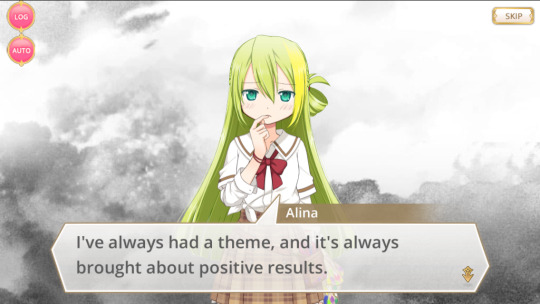
While drifting between life and death, Alina realizes the critic was wrong. She had a theme all along. Alina’s brilliance wasn’t fading.
And thus, since she wasn’t a “dying artist,” her “going out in a blaze of glory” no longer holds any profound meaning. She’s just a silly teenager who got too worked up over a harsh letter.
The overall concept behind Alina’s last work wasn’t the issue. The failure was in the timing and execution, killing herself before such a thing had meaning and in a way such that her body would be found.
And so, I don’t think Alina has learned her lesson here. I don’t think Karin’s words have gotten through to her yet. If she concludes at a later point that her talent is truly is fading or that she’s lost her theme, I’d fully expect her to pull another suicidal stunt again.
Conclusion
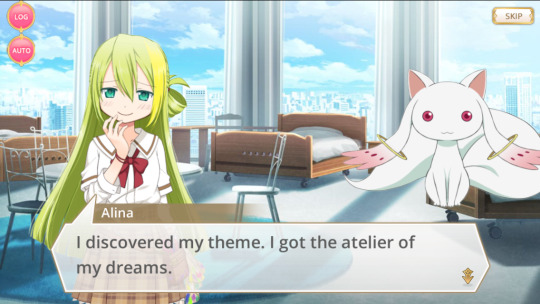
So the good news: Alina lived! She’ll have plenty more chances to create art and figure herself out!
But the bad news: Alina’s revelation implies she’s now even more reliant on her identity as a genius artist.
And thus, like so many other characters, the end to Alina’s MGS isn’t really an ending. She hasn’t solved the problem at the heart of the crisis that led to her wish. Becoming a magical girl and discovering witches does nothing to stop Alina from falling into another identity spiral, nor has she left her suicidal tendencies behind.
Alina found her theme, but she still hasn’t found herself.
Misc Details
Some other neat miscellaneous details that fit with this interpretation:

I’m glad the English translation keeps at least a little of the quirky way Alina refers to herself. (That being said, in Japanese, it’s even more exaggerated - she doesn’t use normal first person pronouns at all, only using “Alina.” )
Because on the one hand, this is an obvious hint at her extreme narcissism: Alina’s sentences frequently emphasize her name.
On the other hand, it’s a great subtle detail to return to the theme of objectification. To put it another way, Alina refers to herself in third-person. That is, even when Alina is speaking about herself, she reflexively frames it from the point of view of another person. Because Alina is constantly having other people’s perspectives forced onto her!

Also, it turns out the pattern of others projecting onto Alina is present in her witch as well! “Old Dorothy” is a historical figure whose diaries have been analyzed by multiple different researchers. Some of them came to the conclusion that Dorothy was definitely a witch, others came to the conclusion she was definitely a normal, upstanding member of her community. The researchers got completely opposite results from the same exact diaries. So therefore - did they truly care about learning what Dorothy was really like? Or were they just out to prove their own theories?
(Two years in, Old Dorothy is even more fitting of a name. Doroinu basically predicted the entire fan response to Alina. Some people see her as an evil (w)itch, some people see her as a sympathetic figure - all from looking at the same text.
We’re even starting to see the “two sides” of Alina come up in the Main Story, with Karin’s subplot in Arc 2.)
Meanwhile, Old Dorothy’s form - a “paint tube” - carries both this “paint over with your perceptions” meaning while also suggesting the same story as Alina’s final piece in miniature.
Unlike Izabel, Alina’s witch form isn’t that of an artist. Because when Alina hits her lowest point of despair, she no longer considers herself to be an artist. She believes the only value she has left is to become literal materials to create art.
In other words, Old Dorothy is Alina turning herself into art again. It’s just rainbow paint this time instead of red.

Last but not least: yes, I am absolutely aware of the irony of this essay. Here I am rambling about how Alina’s story is all about her struggle to be herself while everyone seems determined to erase her in favor of their own projections – and yet a good chunk of this interpretation is probably my projecting on her. Whoops!
Still, even if you disagree with it, I hope this essay was interesting and maybe made you question some of your assumptions about Alina.
Thanks for reading!
#madoka magica#magia record#alina gray#magia record analysis#my ramblings#long essay#read more#tl;dr#alina is certainly exaggerated#but in her MGS she comes across as#a surprisingly believable gifted kid#going through a nasty identity crisis#exacerbated by her fame
282 notes
·
View notes
Text
Does Fiction Lead to Grooming, and The Effect of a Relationship Like Sessrin on a Child Audience.
Ok, so I posted a response on a lengthy thread some time ago that I wanted to update some of my points on, and also repost to be more easily visible since that post ended up disappearing due to some shenanigans.
I also wanted to update this argument, because I’ve started seeing some pro-shippers argue that even if sessrin became canon the romantic portrayal of this relationship wouldn’t affect child viewers. I posit that this is untrue. The very nature of the effect children’s cartoons/media has on the views and social behavior of children is still a field with much academic study going on in it. however, the idea that children like to emulate what they see in cartoons, and the notion that positive portrayals of characters and relationships of diversity in cartoons can lead to a higher rate of acceptance among the child audience to these ideals in real life has so far been a very real, and tangibly proven fact.
The original point of this argument was in response to someone’s statement that made a point along the lines that “media does not affect grooming relationships in real life”, and if it did
“it would affect not only the thought processes of the victim, but that of the potential predator as well.”
My response as follows.
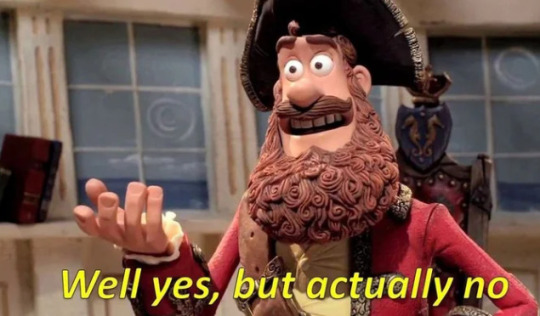
The potential predator we are talking about here is a grown-ass-adult. We are talking about a person who is old enough to know right from wrong, and that children/teenagers are off limits because the law says so. Can pornographic materials stoke the fire of pedophilia, and make someone who is only fantasizing about offending actually take the leap and become an offender? Possibly? But I doubt seeing an abusive relationship on GoT is going to be spicy enough to be the tipping point for a potential future groomer. And even if it were, at this point in the adult’s life, it’s a little too late for them to stand up in court and say “your honor, a television show made me do it.”
In this house, we blame the abuser, no one else!
This is the important distinction though: that we can have intelligent discourse over the problems inherent in these kinds of relationships in adult media. Was ‘Lolita’ a book glorifying an adult man’s attraction to an underaged girl, or condemning it? Is ‘Cuties’ a movie about the dangers children face performing provocative dance moves for an audience of adults, or was it created to pander to MAP’s? Would the relationship between Jon and Daenerys really be ok just because the Targaryen’s traditionally married their blood relations, or would it still be wrong because it’s incest?
Children’s media doesn’t have these kind of deep, introspective themes because children’s brains are still growing, and learning, and these kind of messages can become muddled and confused. We are still constantly trying to find out just how much of an effect media has on the views, and thoughts that children develop as they grow.
From the discourse over marketing toys to children in the form of Saturday morning cartoons, to the use of cartoon characters to sell cigarettes, and the very real problem of the portrayal of race and diversity in children's programming, these are ALL points that have been the subject of scientific and psychological study.
A very quick search brought up MANY articles and peer reviewed theses on these subjects:
The American Psychological Association on Advertising and Children
Influence of Cartoon Media Characters on Children's Attention to and Preference for Food and Beverage Products
The Relationship between Cartoon Trade Character Recognition and Attitude toward Product Category in Young Children
Racial and Gender Differences in the Relationship Between Children’s Television Use and Self-Esteem: A Longitudinal Panel Study
Why Diversity in Children’s Media is So Important
A very interesting study I found was on the influence of Western cartoons on children in Kenya, found Here. It’s a 200-page peer-reviewed thesis, so I’ll try to condense it as reasonably as possible.
The research was performed among primary school children in Kenya who were exposed to the following Western cartoons: ‘Spongebob Squarepants’, ‘Sofia the First’, ‘Lion Guard’, ‘Doc Mc Stuffins’, and ‘Ultimate Spider-Man’. The focus of the study was on the effect of children’s social behavior after viewing those cartoons. As such there were multiple factors considered, everything from the influence of the violence, and language shown, positive messages like friendship and generosity, to views on gender and race.
two of the most startlingly tragic results I read in this study are as follows:
“...a majority of the children preferred white cartoon characters as they have been conditioned to see "white‟ as the norm through the foreign television cartoon programs. This could further explain why the Doc Mc Stuffins was the least popular among the cartoon programs selected for this study as the lead character is dark skinned.”
and
“Having established that a majority of the children preferred white colored cartoon characters, the researcher sought to further establish whether the children would want to have an association with fair skinned children. 56.6% of the children strongly agreed that they would like to make friends with fair skinned children because white cartoon characters are better looking.”
Finally, an excerpt from the conclusion of this thesis:
“The study revealed extensive reliance of children on foreign television cartoons. The study therefore recommends that more local children content especially cartoons need be produced from the developing countries to substitute the current extensive reliance on foreign television cartoons for educational and entertainment purposes by the Kenyan children. There is urgent need for the producers to focus on content that will amplify children’s morals and values such as honesty, generosity, and respect among others; content that will help them appreciate their cultures and the diversity that comes with it.”
So what does all of this have to do with Yashahime and the portrayal of a romantic relationship between Sesshomaru and Rin?
Besides just affecting their views on the things we’ve already discussed, there is also a discernable influence children’s media can have on their views of romantic relationships.
There is a really interesting peer reviewed thesis I found here about the effect Disney movies have on children’s views of romance.
The paper describes interviews they had with children where they would show the children pictures of iconic Disney princes and princesses and would be asked three questions: Have you seen this movie? Are these two people in love? What does being in love mean? The thesis conclusion ended as follows:
“Consequently, this research illustrates the modernization of the oral tradition of folklore from moral messages of honor and duty meant to teach the lessons that will guide children into adult hood, to the Disney formula of love at first sight leading to romantic love. The augmentation of folklore tales in this way produces a new scope of inquiry to examine the potential influence and consequences Disney films have to inform children’s understanding of love relationships. The importance of this study is that it has found that children are creating meanings when exposed to romantically themed media and this influential media effects how children create meaning about their social world. This thesis has described the importance of children being affected by this media, how these meanings are identified and internalized and finally how children are expressing ideas of romantic love.”
A much shorter read over here on Bitescience talks about how even young teens can be influenced slightly by romantic media.
Indeed, there are still a lot of other things besides the media they consume that can affect a child’s views on things like material goods, food consumption, race, gender, sexual orientation, and romance. These views can and do change and grow as the child ages into adulthood, but people who prey on children do everything they can to avoid their targets from growing out of harmful views that benefit the predator’s goals. While many of us might have grown up with relationships like sessrin in media we consumed and learned after we grew older the wrongness of this kind of relationship dynamic, children, and teenagers who have not grown into this knowledge yet are targets for predators. So why do we want to make the predators work easier by spoon-feeding this kind of relationship dynamic to young people?
To close things off here I want to use a personal example. I want to show everyone my very first OTP:

This is Goliath and Elisa from Gargoyles. They are cute, and I fell in love with them as a wee little child of just 9 years old, and I still love them to this very day.
Are they the reason that these days I see creatures like this:
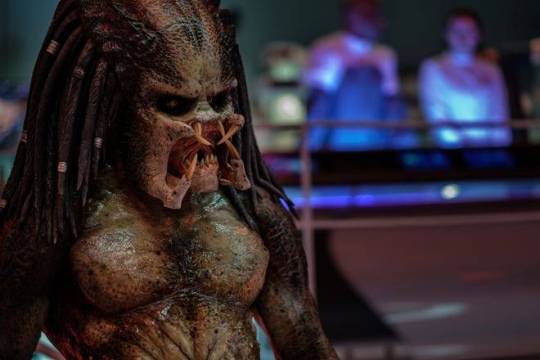
in movies and shows, and go all heart eyes?
I don’t know, maybe? Maybe not. But I wouldn’t be surprised if there was a connection to one of my earliest remembered favorite TV romantic relationships, and this weird obsession I have today lol.
#anti sessrin#anti rinsess#yashahime#inuyasha#antisessrin#hanyo no yashahime#yashahime: princess half-demon#tw grooming
14 notes
·
View notes
Text
Alone Amongst the Gum Trees Part 4 - Digital News Report: Australia - A Murdoch Review
NOTE - this article has been migrated to Medium. As of 2021, A Taswegian Abroad will be closed down, and all of my writing will be published on my Medium profile.
---
After seeing a significant public outcry to my story based on a response to Sally McManus on twitter - I recently spoke with the ABC on being an Aussie overseas and the challenges we’ve faced getting home. The failure once again of Morrison’s government to provide enough vaccines and a proper quarantine system (covered up by the Murdoch Press protection racket) is having real implications on everyday Australians.
I strongly believe that for this to change, the media needs to perform its function of holding both elected officials, and their peers in the press, accountable for such actions.
Until Australia has reestablished media fairness among the press, improved media literacy amongst its citizens, and have mostly removed the cancer of Murdoch’s News Corp dominating mainstream media, we will never break this cycle of government ineptitude, gaslighting, negligence, and outright corruption with little to almost zero accountability.
You don't need to look far for proof. The ones that immediately come to mind for me:
2020 Bushfires and consistent climate change denial - "I don't hold a hose mate"
Freedom of speech is threatened where internet comedians get arrested in their own homes for making jokes about a LNP Deputy Premier
Kate and the horrendous Christian Porter alleged rape case
The four stage plan to make a plan about having a plan for Covid, 18 months into the pandemic, with literally no dates or vaccination targets.
Back in March, I caught onto calls for a Murdoch Royal Commission by former prime minister Kevin Rudd, and since then I’ve been keeping a very sharp eye on the Australian media landscape.
Despite over 500,000 petition signatures and the ramping exposure by Rudd online (leading to a full senate enquiry), the Murdoch press is doing its best to discredit, misdirect, or, blatantly ignore the storm that’s brewing. A couple of major things have caught my attention since that date.
News Corp outlets are still consistently cowing their competitors at Nine, Seven, the ABC, and more into towing the pro-Coalition narrative THEY choose, or, risk facing character assassination. This applies to everyone who dares step out of line: reporters, ministers, producers, senators, editors, presenters, janitors… no one is safe.
This sort of behaviour and influence is not easy to show on graphs and charts, but if you read between the lines, you can see it. Let me show you.

The ABC Presents the Data
In April of 2021, the ABC published a fact-file article outlining the power of the Murdoch press - the first article from an at least somewhat reputable source addressing this that I’ve seen on this topic.
The biggest things I took from it are that despite there seeming to be a diverse ownership pool across many mediums, News Corp (Murdoch) newspapers significantly dominate the national market for print papers, and, have recently been crowned leaders of the #1 source of news for Australians: social media (via mostly viral, opinion, and video based content primarily from News.com.au and Sky News pages on Facebook and YouTube).
Remember this point - spoiler alert: it’s important.
At the recent senate enquiries, News Corp claims there is in fact diversity - focusing on different mediums such as online, social media, radio, television etc. available to represent “diversity”. This is response refers to medium diversity, and is quite frankly a misdirection based on a technicality to avoid the real question. Classic News Corp.
Rudd says “each story published online or broadcast over the airwaves finds its point of origin in a print story, often a Murdoch print story". The former PM is referring to content diversity where factual reporting reigns supreme, and different points of view are given equal time in the sun without the blurring of opinion and fact.
As Kevin likes to say: “pigs might fly”
While you might be thinking “so what? News Corp is strong in print and social, Nine is strong for television and online news, ABC is strong on radio and social, Seven is strong on radio and television etc” - I’d like to ask you a question: where then is the accountability for elected officials in the media?
The Murdoch press won’t say a word about the Coalition’s ever growing laundry list of corruption, negligence, ineptitude or incompetence, but if a Labor politician sneezes, they’re likely to be labelled a Covid super spreader on the front page of 15 national and state papers the next day.
How about this doozy from the Herald Sun in May 2021 after Dan Andrews quite literally broke his back and took medical leave:

I didn’t see one peep from the Murdoch reptiles about Morrison's three day actual disappearing act only last week after his bogus "AstraZeneca is OK for under 40’s / go to your GP” comments.
The key thing to point out here is that the news provider who ranks number one in Australia's largest news medium (social media) is a well known right wing protection racket that doesn’t show any signs of slowing down, and there's mountains of evidence that exists to prove they don’t play a fair game.

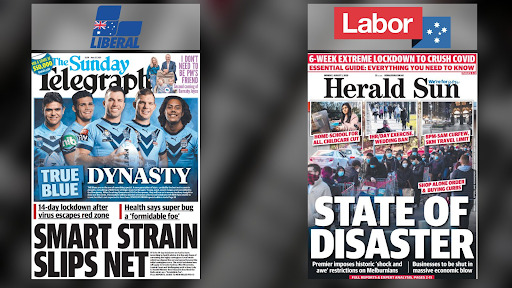
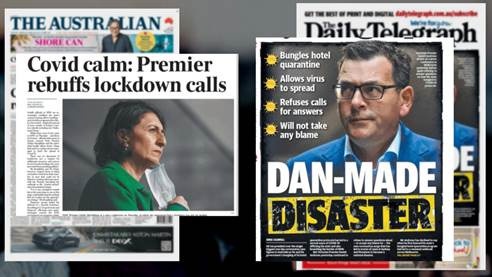
Let’s Go To the Numbers
To really drill down into how important online media control is, I found the Digital News Report: Australia 2021 (i.e “the report” for the rest of this article), recently published by the University of Canberra by way of the Reuters Digital News Report: 2021
Below I've outlined a number of key headers from the report, and more specifically tried to point out exactly where Murdoch and News Corp are exploiting and manipulating their way into control. The data shows us both what has been going on, and the direction it will likely continue in.
Having worked in digital marketing for the better part of the last four years, I couldn’t wait to dive into this data and explain just how much of a rort this all is for the sake of profit.
1: Local News
Replaced by Murdoch Sky News, Invests in Social Media
“For ‘hard news’ such as local politics, economy, crime and health, local news consumers continue to turn to traditional local news outlets, such as the newspaper or TV. However, for most other news and information, consumers are using internet search and other internet sites to get localised information.”
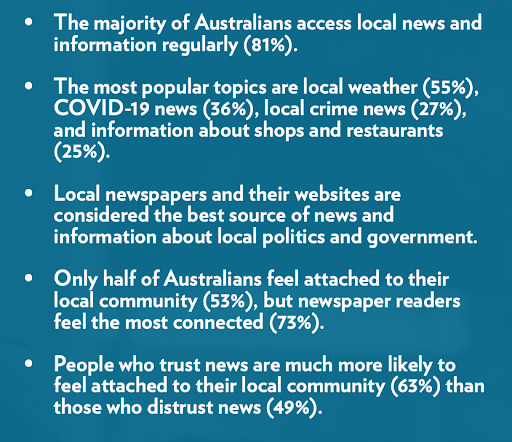
The report tells us that:
“2020 was a difficult year in Australian news sector, with news companies closing or suspended. This is in part a response to the COVID-19 pandemic, but it reflects a longer-term gradual decline in newspaper consumption that is replaced by online offerings”
So why did the BBC report in 2020 that Murdoch shuts 112 Australia print papers in major digital shift? CNN covered it too, as did the Guardian. I couldn’t find anything on a Murdoch owned site or outlet. That’s because Rupert is rolling out “Sky News Regional” to replace them all.

The report outlines:
“This year’s data highlights the important role of newspapers in generating a sense of community, particularly among older news consumers . Further, newspapers are perceived to be the best source of information about local government and politics, which is central to the functioning and accountability of local communities. It is important for industry and government to remember that the closure of a local newspaper not only leaves a gap in the provision of quality news, but also a loss of critical information that is connected to people’s sense of attachment to their community”
How on earth does one far-right Sydney run “news” channel represent hundreds of regional communities? Answer: It doesn’t - it’s designed to influence regional voters to think the way that suits the Murdoch press agenda.

2: Impartiality of News
Murdoch Cuts ABC Funding via Coalition, Ramps-Up Online Polarisation
The report tells us that
“traditionally, values of independence, and impartiality — or ‘objectivity’ — have been central to journalism’s mission and deemed important to perceptions of trust in news. However, in the digital media environment, former demarcations between news, features, opinion, and advertising continue to blur.
“News audiences are becoming more polarised and are increasingly attracted to news brands that offer partisan perspectives.”

What you’re seeing here is that while the data reveals a strong desire for news outlets to attempt fairness, balance, and an impartial approach to reporting - the demographics more likely to use social media (the medium that Murdoch now leads, mostly containing Millennials and Gen Z) are less supportive of impartiality, neutrality and giving equal time. More on this in Part 8.
On the flip side:
"news consumers who prefer impartiality are much more likely to say they distrust news on social media.”
“Both the 2020 and 2021 data highlight that these traditional journalism ideals are more strongly supported by older generations and those who use traditional sources of news."
You need not look further than the blatant defunding of the ABC to see how the Murdoch Cancer continues to take over.
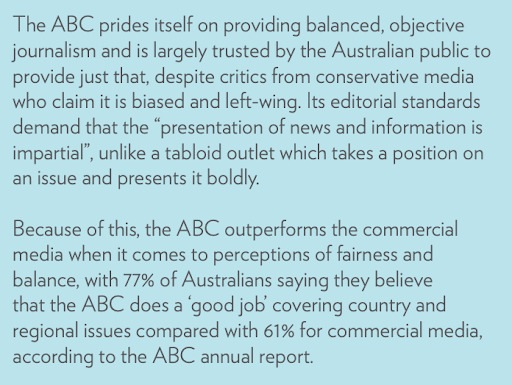
So, if the majority of Australians believe the ABC is impartial and does a “good job”, why has the ABC had $783m in funding cut since 2014 by the Coalition government?
Seems to suit the Murdoch agenda pretty nicely.
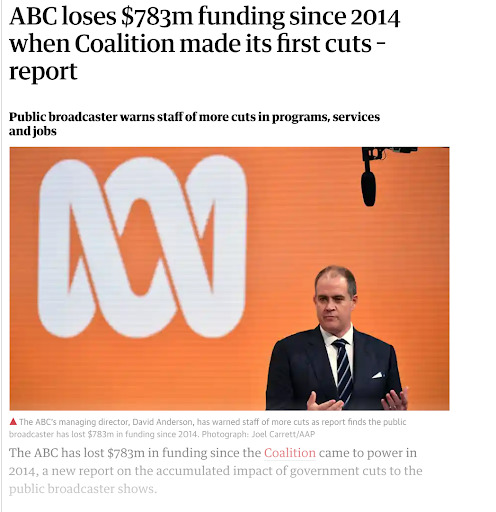
3: News Representation
Low Media Literacy in Under-Represented Demographics
“Importantly, a large proportion of Australians say they don’t know if the amount of media coverage of ‘people like them’ is sufficient or fair. Those who have low education are much more likely to say they don’t know. This indicates a lack of engagement and adequate media literacy to identify misrepresentation and bias in the news.
“Combined with a lack of awareness about misinformation, lower interest in and consumption of news, these findings confirm the ongoing need for targeted media literacy interventions"

The only way the public can push back against misinformation is by knowing they’re witnessing it first hand. That does not suit what Murdoch is selling.
Misinformation breeds confusion, smoke and mirrors, and is aided by political spin, gaslighting and stone throwing to keep people moderately confused and ultimately giving up on understanding the “truth”, or, deciding their own convenient version of truth.
The closure of the Australian Alternative Press due to revoked funding by Nine and News Corp in 2020 should be enough to tell you the media landscape is gravitating consistently to the right.
4: News Access
People Losing Interest, Murdoch Keeps the Elderly Onside
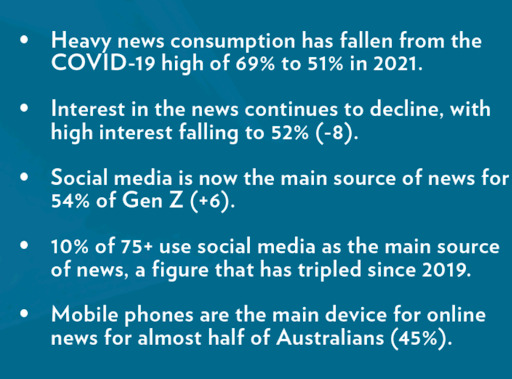
As traditional mediums (television, radio, and print) are on the decline, social media and online news is on the rise with the aid of mobile device popularity (45% of Australians preferred news devices).
It's not a surprise to learn that during COVID-19, older Australians have increasingly turned to social media platforms to get news.
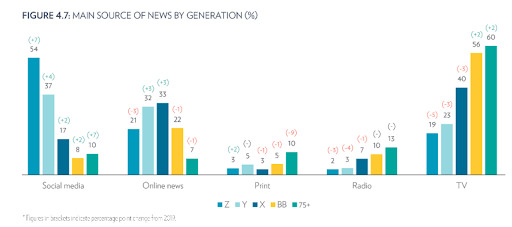
“The percentage of 75+ who use social media as their main source of news has more than tripled in two years from 3% to 10%. Among this age group, social media is now comparable to print use.” the report states.
While it’s hard to point this as a direct plot by News Corp, this is still great news for Murdoch. All News Corp had to do was weaken the traditional mediums that aren’t making them as much money, and push the audience toward social media. It worked.
75+ votes still count, and they are more likely to click the “clickbait” articles to make News Corp that sweet, sweet ad platform revenue.
5: Emerging New Habits
Murdoch Funds the Fuel for the Fire
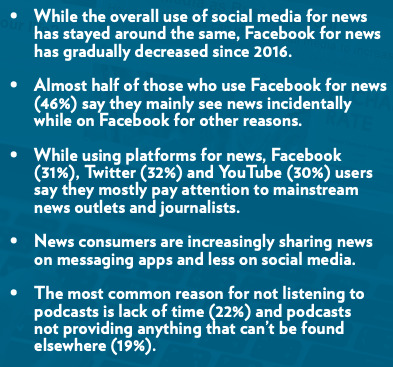
Despite people being somewhat varied on their social media usage for news specifically, the important statistic here is that more than half of Australians consume news videos.
The below statistics from the ABC should set alarm bells screaming. To put it plainly:
More people on social media than ever before
Murdoch ramps up social media content (Facebook posts / videos & YouTube videos mainly), then mega-funds paid advertising on said content
Drives subscribers and views through the roof
Overtakes ABC (yes, the one he’s got his politician friends/puppets actively defunding)
Don’t believe me? See for yourself.
The ABC outlines that:
“Fact Check has analysed audience data for media accounts on what Canberra University found were the two most popular platforms: Facebook (used by 39 per cent of news consumers ) and YouTube (21 per cent).”
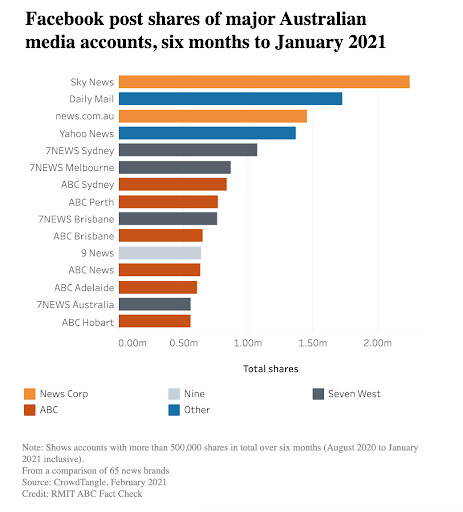
“Data from the analytics site Social Blade shows that Sky News Australia's YouTube channel had more than a million subscribers at the start of 2021, having doubled its following in just six months. Its subscriber base began to pull ahead of Channel 7 and Channel 9 from mid-2020, and by March 2021 Sky had overtaken ABC News”
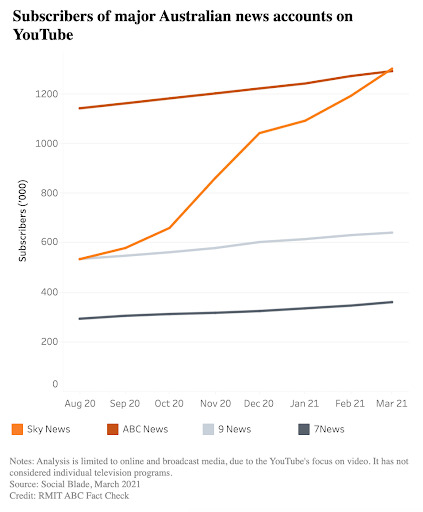
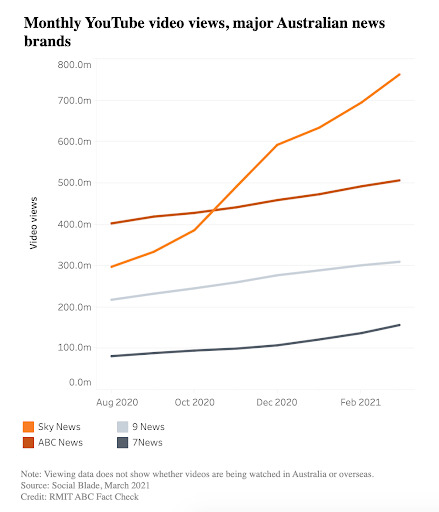
The University of Canberra report aligns to these trends, and summaries that:
“Australian news consumers are accessing news online from a diverse range of sources including news videos, podcast apps, and numerous social media platforms alongside traditional branded news websites.”
“Although social (media) is the most common main pathway to news online it is common for consumers on Facebook, Twitter, YouTube and Instagram to say they mostly see news incidentally while they are on those platforms for other reasons.”
6: Trust and Misinformation
Rupert’s Bread & Butter
“Tackling disinformation and misinformation is complex and won’t be solved by platforms alone. Responsibility must be shared across governments, digital platforms, users, news media and society to make sure Australians can access accurate and reliable news and information online, while ensuring rights to freedom of expression are protected.”
Creina Chapman, Deputy Chair, Australian Communications and Media Authority

This in part ties back to my earlier points in part 3 regarding media literacy - the report indicates that trust remains high where people use both multiple mediums AND multiple sources for news. This is further compounded by the evidence that low educated readers are less likely to know they’ve encountered misinformation.
The report confirms this by indicating:
“The differences between high and low educated Australian consumers in relation to concern about COVID-19 misinformation and their ability to discern it, points to an ongoing need to boost media and information literacy among socio-economically disadvantaged groups in Australia”


The ABC and SBS still continue to be the most trusted brands, however, it needs to be highlighted that “Local or Regional Newspaper” comes in third (62% trustworthy) - the vast majority of which Murdoch owns.

In 2020, survey participants were most concerned about Australian governments and politicians being sources of general misinformation (35%), followed by activists or activist groups (20%).
Despite this, 2021 shows that trust in news has increased in 2021 (43%), rebounding off trust associated with COVID-19 news reporting. The report breaks this down further:
“The data show(s) that concern about journalism as a source of misinformation about COVID-19 is very low (9%). In 2018, we asked about ‘fake news’ and 63% of news consumers said they were concerned about poor quality journalism as a source of ‘fake news’, and 40% said they had encountered it. This signals a possible positive shift in perception of journalism after 12 months of reporting expert health advice about the COVID-19 pandemic.”
"The data also highlight(s) ongoing low levels of trust in news found on social media (18%) compared to trust in news generally. Given much of the news encountered on digital platforms is the same as that which appears on the homepages and front pages of well-respected news brands, the findings suggest that the nature of the online environment itself is one the factors lowering perceptions of trust, rather than the news content."
Creina Chapman, Deputy Chair, Australian Communications and Media Authority states in the report that:
“In the context of online news, nearly two-thirds of Australians remain concerned about what is real and fake on the internet. And a variety of surveys over the past 12 months have shown a concerning portion of the population believe dangerous falsehoods about COVID-19 that have been circulating online.
"Any lack of trust in authoritative or reliable sources of news and information is particularly worrisome during a global pandemic, as it may drive people to spaces where misinformation is more prevalent. This, in turn, increases exposure to false conspiratorial narratives that can result in real-world harm to both individual users and broader societal institutions”
Where does Murdoch benefit here? Same as always: smoke, mirrors, confusion, and spin all wrapped into enormous volumes of social media content.
7: Paying for News and Funding Journalism
Conveniently Avoiding the Issue
“To ensure media diversity and plurality in Australia, a mix of substantive, fiscal measures is necessary to support, transition and stimulate existing news businesses and encourage new entrants”
Anna Draffin, Chief Executive Officer, Public Interest Journalism Initiative

Despite a fair and balanced media being a must-have for any democracy - this is not surprising, given the low amounts of trust for online media content. Overall, given that Australians are not concerned about the poor financial state of news outlets, it’s sad but not surprising that many feel the government should not step in to help.
What is the most dangerous here is the simple fact that when there’s no money to fund decent and ethical journalism, we end up with tabloids, opinion pieces, shock jocks, and anything that just gets you to first: SEE it (an “impression” in the marketing world) and second: CLICK on it. Both of these things make News Corp richer.
Here’s the report evidence:
“A quarter (25%) of left-wing news consumers and 27% of centre-leaning are supportive of government intervention (to assist struggling journalism). However, more than half of right-wing (58%) news consumers are opposed to government assistance for financially struggling news companies."
“This is consistent with the findings that left-wing news consumers are more likely to say they are concerned about the financial state of news businesses (41%) compared to centre (37%) or right-wing (34%) news consumers”.
News consumers who think their political views are represented fairly for online news are another win for Murdoch. This is compounded by the fact that those who think news should take a position are also more likely to pay for that news.
That means if the mainstream media is pro-right wing, for example, then more people look at right wing news and pay for right wing reporting, ultimately leaving the left without funding, and fighting a losing battle. All Murdoch needs to do is discredit who he deems as “left” and it’s game over.
But Murdoch doesn’t need subscriptions. That’s just pocket money for him. With the introduction of the News Media Bargaining Code, Rupert & News Corp continue to improve their financial revenue streams through digital marketing strategies (views and clicks) without needing people to pay for fact based, objective journalism.
8: Political Orientation
Stealing the Centre & Making Opinion the “News”
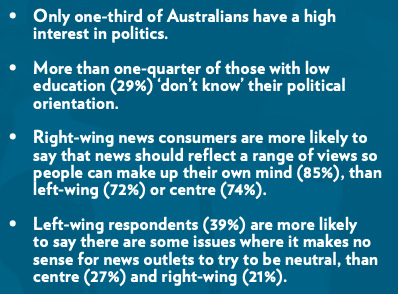
Of all the elements of this report, this one shocks and upsets me the most.
The majority of Australians (61%) identify with the centre-left of politics (30% political ‘centre’ and 31% identify as either ‘very left-wing’, ‘fairly left-wing’ or ‘slightly left of centre’).
Only 22% of Australians align themselves with the right wing, and 18% don’t know their political orientation.

Younger generations have historically been the drivers of progressive social change, and younger Australians are more concerned about the environment and the impacts of things like climate change and equality.
Clare Armstrong, National Political Reporter at the The Daily Telegraph outlines in the commentary that:
“many young Australians may rightly feel their futures, livelihoods and social activities have been either jeopardised or overlooked by a centre-right government, and subsequently a larger cohort has been pushed toward the left”
To begin in closing, based on this - how do Conservative/Right Wing parties keep winning federal elections?
It’s by doing exactly what we’ve mentioned in the first 7 sections:
Flooding the online and social media landscape with non-factual spin and confusion
This is aided by the bedrock of owning the majority of national, capital city, and regional papers which in turn steer the daily political narrative on television/radio
This is all driven home by bullying competitors into following suit, or, suffering the consequences
There is no governing or peer run body with teeth (or guts) to hold Murdoch and News Corp responsible or accountable
According to the report;
“Younger generations, who say they feel less attached to their local community, and who also access social media widely for general news, are more likely to seek local news and information from the internet and online platforms.”
As Clare Armstrong also states:
“Social media has significantly fuelled political polarisation in the last decade as its algorithms, by design, show users more of what they want to see, rather than a broader mix of ideas presented in traditional media.”
In summary - this quote from the Political Orientation trends leaves a long-lasting impression on my psyche:
“Left-wing news consumers (61% of the country) are more comfortable with news that takes a position rather than maintaining neutrality.”
Rupert has them right where he wants them: thinking that opinion is news.
3 notes
·
View notes
Text
Keep your Lamps trimmed and Burning
Today, I ask all of you to burn a candle. Set the wick on fire and say prayers or whatever you do to connect with God or the universe. Yesterday, the Wright family lost their son. A baby boy lost his father. Siblings lost their brother. Friends lost a friend.
I need you all to find the will and energy to understand the situations at hand. A young man, lost his life at a traffic stop. Daunte Wright was pulled over for having an air freshener dangling from his review mirror. Everyone will argue that he shouldn’t have resisted. Well, let me ask you this: are you going to step out of the car when police officers tell you “you’re under arrest and we’ll tell you when you get out?” How is that professional?
Are you actually going to step out of the car when law enforcement doesn’t give you ANY reason or explanation as to why you are being arrested?! I’m pretty sure you all will say no. I’m pretty sure you all will ask for a reason until it’s “acceptable” but even then. Do you know how many people are placed in jail for crime they didn’t commit? But that’s another point for another day.
A study made by NYC and the Stanford Open Policing Project that black drivers were about 20% were more likely to be stopped than white drivers “relative to their share of the residential population.” It was also discovered that once black drivers were stopped, they were also searched 1.5 to 2 times as often as white drivers.
Numbers never lie. Unless you change them. So you tell me in light of the events of yesterday, how isn’t this a systemic problem?
I come to the conclusion that media will always lie to make the victims look like criminals. I watched a video of Daunte Wright’s mother explaining her experience of when he was pulled over. It was heart breaking to hear his parents talk about the LAST time they saw their son. Mind you, all of this happening during the trial of George Floyd. Do you see the red wound opening up again for the black community?
How can we can sit here and watch these wounds bleed, when we have the power and resources to make change possible. Yes, change and progress take time. But THIS is history. Black HISTORY has always been sidelined so that white history can prevail and be the “prosperous people of the future”.
They didn’t do shit but rape and pillage land. All Europeans SHOULD acknowledge and repair the damage done on history. Do you think anything has changed over the last few generations? No. It hasn’t changed because people, especially white racist people don’t want to take responsibility. They don’t want to acknowledge the past because they’re scared of losing power and not being in control. Racist white folk want to keep on being the powerhouses. And that’s just not it.
It’s all an illusion. White lies. To pretend that history is behind us. Yeah, tell that to Daunte Wright, George Floyd, Breonna Taylor, Ahmaud Abrery, Philando Castile, Sandra Bland, Eric Garner, Walter Scott, Michael Brown, Freddie Gray, Tamar Rice, Atatiana Jefferson, Rekia Boyd and the countless others. How many lives could still be breathing today if the system wasn’t against them.
Do you know or understand the deep mistrust with law enforcement and the black community. It wasn’t long ago, during the Jim Crow Laws, towns claimed themselves to be “sundown towns”. This meant that towns could use any means necessary to intimidate and harass black people who stayed in their town after sunset. Most of the time it ended in the death of black civilians. Half these harassments and intimidation tactics were made by white police officers. Killing for sport.
Black lives aren’t animals to be hunted. Yet, that is what history did. There are articles and archives with this documentation. You can look it up or learn about it in Lovecraft Country. So don’t sit here and tell me that racism doesn’t exist.
You have all the tools available for you. Books, documents, archives, movies, music, shows and people’s experiences to tell you about black life in America. So don’t say you didn’t know, because you do, but you choose to see what information is good enough for you.
No, this shit is rough. It’s beyond upsetting. It’s infuriating. It even makes you feel powerless at times. BUT ITS FUCKING IMPORTANT because black lives are at stake. Their lives matter! You use them and abuse them and them kill them without question or thought. White America is nothing but white lies and bloodshed.
America Strived to be the “land of the free” and advertised this to the WHOLE world. This land was never yours. And yet, you expect the rest of the world to bow and kiss your stinky gross white ass feet. No. Don’t get mad because you so called claim to be the all mighty. This is your consequence. People will make it clear how wrong you are, White America.
People aren’t stealing your jobs. You’re lazy and entitled and can’t do absolutely NOTHING for yourself without help. You complain about every foreigner and culture and yet YOU TAKE ASPECTS of all these cultures and say you did it.
Yeah, and what about the Native Americans? What about every population you forced out with diseases and religious conversion? Huh? You still have outcasted indigenous folk. You’ve done absolutely nothing but take from them and black people.
LIARS and MURDERS that’s what history is and it’s people. You can get away with murder and rape. You can storm through the capital without a scratch or bullet. YET all you do is cry like a child when you don’t get your way.
Don’t expect compassion for your sad attempts of understanding. YOU have the resources. DO THE WORK. If it actually fucking matters to you, THEN DO IT. Stop asking your friends in the black community about what to do or how they feel. Pay attention to yourself and make this place better.
As for the Wright Family: I am so very sorry you didn’t get a chance to say goodbye to your son. I am so sorry you had hear your son last words through the phone. I am so sorry that no matter how hard you try to live a happy life, the system continues to be against you.
Your son deserves to be alive. He deserves to be with his son. He deserves joy and happiness and it was taken from him far too quickly. I know that words are never enough to take away your pain. But my heart is with you. My prayers are with you. I will send you all my forces and strength for this difficult time. I will continue to fight for every black life. I will continue to stand against hate. I will make sure people are educated and learn about the racism against black life.
To every black souls lost due racism and violence, may you find ever lasting peace above. 🕊
Links:
https://en.m.wikipedia.org/wiki/Sundown_town
https://www.gofundme.com/f/dauntewright
https://www.nyu.edu/about/news-publications/news/2020/may/black-drivers-more-likely-to-be-stopped-by-police.htm
#blacklivesalwaysmatter#blacklivesmatter#justice for daunte#justicegeorgefloyd#justice#black lives are beautiful#justiceforelijahmcclain#racisim#inequality#justicedauntewright#daunte wright#justice for breona taylor#justice for black people#justice for black lives#blm
4 notes
·
View notes
Note
For the AU headcanons: Tissaia/Yennefer. Flower shop AU.
oh my god this one’s so long i hope you’re ready
(i’m gonna wind up writing it)
when she was very young, Tissaia absolutely loved hanging out in her grandparents’ flower shop. the shop passed on to her parents when she was around 10. she learned all about the flowers they kept for arrangements and so on, the interest extended to other plants, and she eventually went off to university to study botany. (thesis: conservation and rehabilitation of... perfoliate pennycress? lesser butterfly orchid? kinda like pennycress bc it grows on old walls, etc, but moths are a big pollinator of the orchid and! Tissaia! moths! idk why that got me so excited)
a couple years back her parents - who were a bit older when she was born - decided they needed/wanted to give up the shop, and in a bit of a fit of sentimentality Tissaia offered to take it over. her parents retired away to the countryside, leaving the flat above the shop open, but Tissaia rather liked her current flat, thanks. besides, it was p clear that she would need help, esp if she was going to keep going with her projects and papers she was working on for, you know, the work she has a degree in.
along comes one Triss Merigold, who is immediately at home in the shop and happens to be looking for a place to rent. she’s also down with the greenhouse on the roof and looking but not touching, which was a big thing for Tissaia. her parents let her put it up there way back when she was at uni, and she’s left everything there over the years because it’s easy and because the one thing she hates about her current flat is a lack of natural sunlight. anyway Triss runs the shop most of the time, Tissaia keeps her project plants (and a handful that are just great for selling clippings of) on the roof, and she gets to keep working on the academic paper that will get to the peer review stage one of these days, everybody’s happy
one day, Yennefer is on her way to... a funeral? a friend’s commencement? eh... and realizes last minute, literally as she’s walking by this flower shop, maybe she should be getting something? fuck. fuck she’s empty handed she definitely needs to get something. she barrels into the shop because she spies some small arrangements in the window that are ready to buy (Tissaia keeps a small stock), grabs one that looks nice, and stops dead at the counter because fuck the woman behind the counter is hot? she’s got spectacles balanced on the tip of her nose and she’s elbow-deep in an arrangement of blush coloured roses that bring out the blue of her eyes and oh shit, Yennefer’s in trouble.
Yen kinda starts babbling awkwardly as Tissaia extracts herself from the arrangement and washes her hands, and lets slip where she’s going. Tissaia kinda looks at the bouquet, arches her brow, and walks her back to the display of pre-made arrangements to pick something more suitable. “do you have a few minutes?” she asks. Yennefer doesn’t, really, but she nods anyway. Tissaia takes a few blooms out, replaces them, and shows Yen the new bouquet. after she’s done Yen is like ‘oh fuck she’s gonna charge me more for this isn’t she’ but she doesn’t, she pays the advertised price, and she goes on her way. she makes it to the event RIGHT on time.
Yen might pick a new place to shop for groceries that requires her to pass by the flower shop after that. she might find excuses to go in and buy bouquets. she might be disappointed when she finds Triss there after her extended holiday is up and not Tissaia. Triss immediately susses out what’s going on, and might or might not let drop when her next day off is (and that she and Tissaia are the only ones who work the shop). oh, and also that those cuttings in the corner are from the greenhouse on the roof, which Tissaia tends religiously.
at this point Yen is just buying a new bouquet of flowers every time the one on her table dies, because lbr, she’s not giving this many people flowers. and fresh flowers on the table is surprisingly nice? she’s horrible with plants, really, so the fact that these are kinda expected to just die at some point makes her feel a little better
she mentions to Tissaia one day that she’s got the opposite of a green thumb, but she likes the colour. Tissaia gives her a bouquet of alstromeria, which notoriously last for fucking EVER in a vase until one day the flowers all just fall off, and also recommends maybe she pick up a philodendron or sth if she wants an easy-to-care-for house plant. Yen’s like “a what?” and Tissaia just laughs and offers to have one for her next time she comes by.
which is a while because the alstromeria really won’t fucking die omg go away flowers!! give Yen a reason to go back to the flower shop!!! (one day she finally just yanks them out of the vase to throw them away feeling a lil guilty about it but even though they didn’t show any sign of drooping like all the blossoms just topple down to the table from the shaking and she feels less bad lmao)
(the philodendron does ok but she keeps showing up with questions about it until she’s confident that she’s not fucking up this poor plant)
anyway this goes on for a while until one day Yen’s in the garden center bc she’s thinking maybe she can get another plant from a List of Plant-Killer Resistant Plants provided by Tissaia and she spots this very pretty moth orchid and the tag and google say it’s good in low-light spaces and she remembers Tissaia mentioning her flat doesn’t get a lot of good natural light and she buys it without really thinking and she’s fucking walking through the shop door when she starts to panic because fuck FUCK she’s bringing a fucking FLOWER to a BOTANIST who owns a FLOWER SHOP and has a GREENHOUSE
she voices as much but Tissaia is just “no? it’s lovely?” because nobody buys her plants for those very reasons and yeah she’s got a handful of low-light plants scattered around her flat but it’s very thoughtful and sweet and their first ‘date’ is def just Tissaia giving Yen a tour of the greenhouse and showing her a couple different species of orchids she keeps in there as well as all her other plants, some of which, again, threatened and they’re there for her to study and try to propagate.
i hate that this is over 1k send help
(send me an au and i’ll write 5+ headcanons about it)
#yennaia#the witcher#tissaia de vries#yennefer#au#askbox prompts#arwen writes#long post#Anonymous#au headcanon meme
39 notes
·
View notes
Text
The Charming Empire - Otome Review (Soshi Amazaki Route)

I was going to hold off on doing this because 1. I wanted to play more routes to have a more comprehensive look at the game and 2. I don’t really have free time yet. Promptly ignored the above logic mostly to get this out of my system.
Before we begin, a disclaimer - While I do have pretty extensive knowledge about the otome genre in both longer “proper” VNs as well as the shorter, bite sized mobile VNs, I’m able to derive enjoyment from most anything (I feel the need to point this out because I see a lot of reviews that get hung up on stuff I can easily brush off even if I do understand where they’re coming from).
This is going to be a spoiler-free review based on Soshi Amazaki’s route alone.
Firstly, I must note that this is a mobile otome game. If you’re looking for something as long and substantial as, say, Hakuouki, Alice in the Country of Hearts, Dandelion, etc. this is probably not the game for you.
Now that that’s out of the way, I’ll be rating it based on usual points with a more... comprehensive and personal look at the end (feel free to skip to that if you know our tastes align and/or just want to see me losing my mind).
Prologue - 1/10
Normally I wouldn’t separate prologue from story. However, as this game started as a mobile game, there is no general route in which one gains points toward a love interest as is standard in full-length otome games. However, even by mobile game standards this game’s prologue fails in that it you meet exactly 0 love interests. Indeed, the prologue is the bare-bones introduction of the setting. This flaw is further complicated by the fact that, because it started as a mobile game, routes are bought individually. This means that there is no way to gauge the love interests except by the game’s straightforward summary on the buy screen. Luckily for me, I was sold at “Kenjiro Tsuda voices a love interest who is both a big brother and a lord” so this wasn’t as knee-capping as it could’ve been, but normally you’d have to simply take a leap of faith because if a love interest doesn’t actually end up being your type, you’re out of luck since you’ve already paid for the route.
This is an aside, but translation for the prologue is... questionable. It isn’t unreadable, like some translations I’ve had the misfortune of reading, but it does create some confusion regarding the MC’s family situation which I can’t help but clear up here. MC is the daughter of the previous lord whose mother moved with her out to the countryside. Her mother is died of illness, and MC now lives with an elderly couple. It’s simply when I say it here, but in game the family situation isn’t actually explained until well into the route and the narration refers to the couple as the “old man” and “old woman,” while the MC calls them “Grandpa” and “Grandma” (ojii-san, obaa-san in Japanese, which is a literal translation of what someone would call any older folk with the degree of familiarity MC has with them) while they call her “princess” (literally, hime-sama). The closeness of referring to them as grandparents vs the distance of the narrative’s “old man/woman” + calling the MC princess in a literal sense (vs. a nickname) is jarring especially because, again, they do not clearly explain the MC’s family situation.
Story - 7/10
Soshi holds the most powerful seat in all the empire. Only trusting himself, he rejects the opinions of others as he continues his dictatorship agenda -- breeding animosity amongst the people. He’s a cold man who sees even his own sister as a political tool.
This is the official description for Soshi’s route. Unfortunately(?) for some this... doesn’t really hold true for most of the route and I find it an odd way to bill it.
The initial conflict/relationship growth in the game stems from the MC wanting to be closer to Soshi - not necessarily in a romantic sense - and his distance due to his position. If you’re expecting a more haughty/sneering/pragmatic Kenjiro Tsuda more along the lines of his role as Kazama Chikage and/or a villain archetype who treats MC as a tool (no judgment, we all got our otome types) he’s by and large not that. Things get more complicated around the 10th chapter, but that’s 2/3 of the game in.
The writing is competent. Again, if you’re looking for complex worldbuilding and something deep, you will not find it here. But, while it isn’t poetry in motion, there was at least no point where I actively cringed or asked myself why I was playing it (this is compared to my experience with Voltage Games and Playchoices).
The MC is tolerable. There’s nothing special about her, but she avoids being a literal faceless protagonist with zero presence while also not having such a strong personality as to be polarizing. She shows more competence and restraint than I expected of her (the bar was nearly floor level, but still).
The pacing is... odd. I get the distinct feeling that it’s a longer otome shoved inside a mobile otome, if that makes sense. I’ve seen other reviews call it rushed, but that isn’t necessarily the feeling I get. For a game to feel “rushed” to me, it has to show a lack of care and attention to detail; scenes are had just to have them and either don’t contribute to the overall plot/theme/feeling of the game. I feel like this game does take care, especially in it’s early bits, but some developments happen later on which don’t get the development time they necessarily need. Which leads me to-
The plot kind of goes off the rails around chapter 10 or 11. It returns to form in chapter 14ish. This... plot twist, shall we say, is predicated on hiding obfuscating knowledge from the reader that should be apparent due to being from the MC’s PoV. Whether or not this is a dealbreaker will depend largely on the person. Personally, I was loopy off resisting sleep medication while reading this part so I just sort of accepted it and the return to form/explanation in later chapters made it worth it, but your mileage will definitely vary. I have Thoughts on this, but this is all I can really say while still maintaining a spoiler free review.
Playtime if ardently listening to the voices is ~3 hours. Playtime can be cut down significantly if you’re a fast reader and don’t overly care about the voice acting.
I haven’t tried all alternate options, but there doesn’t seem like huge variations regarding the choices. The 16th chapter, however, will change based on whether you get the Normal or Happy End.
Art - 7/10
The art isn’t anything special nor is it terrible. It’s much less stiff and has more style to it that most mobile otome’s I’ve played, but is lacking when compared to, again, full length otome games.
The MC has a face, which gets points from me (I dislike faceless MCs a lot especially when included in CGs). The fact no one but love interests even get sprites is somewhat jarring.
As far as CGs go, they’re standard fare and about the number you’d expect for the length of a route. The game isn’t raunchy like... at all so don’t expect anything too scandalous.
Voice Acting - 10/10
What can I say? It’s Kenjiro Tsuda.
To elaborate, however-
Kenjiro Tsuda does an excellent job. I’m not sure if I’d call it his best work, but even if it is voiced, I think there’s some expectation for a mobile otome’s voicework to be phoned in. This is not the case and Tsuda’s acting gives a lot of life to the character and scenarios. I’ll, uh, save my gushing for my line-by-line dissertation, and leave it at that.
What was unexpected was, despite not having sprites, minor characters do get voices! They also have some rather nice performances, and there was no VA I disliked listening to or whose performance was noticeably lacking compared to the others (the actual sound quality was consistent overall as well).
Overall - 8/10
Aside from the prologue, this is a solid performance from a mobile otome game. Compared to full-length otome games it’s lacking, but it’s still one of the better mobile otomes I’ve played. For the $6 you can get individual routes for on the mobile app, it’s a fun, quick romp that was perhaps not necessarily what was advertised (regarding the actual summary), but instead met the expectations I dared to dream of. While I can’t vouch for the game in its entirety, I can, at the very least, vouch for this route.
Comprehensive Overlook + Personal Rating - 10/10
Okay, I’ve been objective as possible despite this being a very subjective topic and now it’s time for me to shill my little heart out.
Writing a standard fare review for this game was really really hard for me because against all odds, logic, and my own taste preferring shit like Hakuouki, I’m in love with this game. Obsessed with it. Half the reason why I’m doing this is because it is a totally unremarkable (though, again, fun) otome game so of course it doesn’t have, like, a community, but I need to fucking gush about it somewhere.
Why?
Because Soshi Amazaki literally hits every single husband trait I so dearly love. This route is the equivalent of if someone took my taste buds and analyzed each and every one of them, then cooked a meal precisely on my most loved things. It isn’t necessarily fine dining, but it feels like it was scientifically engineered to appeal directly to me. It’s like I was possessed and ghostwrote it. It’s like someone peered into my heart and teased out the essence of everything I’ve ever wanted, then told me to eat shit because the shell it’s rammed into is that of a bite sized otome game. I have never had such a feast before me. I’ve never been served such an exquisite palette of flavors. I have never been so thoroughly outraged that this is the form my heart takes.
And yet, I’m... pretty much satisfied, despite its flaws and shortness, with my only real outrage stemming from the fact there is literally nobody I can talk about this with (the morning after I binged the entire route I made my boyfriend play it just so I could rave like a lunatic to someone about it) as well as my shame for being so enamored with what is essentially a mediocre otome game.
I talked about how the story kind of went off the rails 2/3rds of the way through, but honestly? I didn’t care because the payoff was incredible. Was I scared the game wasn’t going to end up where I wanted it to while it was happening? Was I prepared to be immensely disappointed because I felt, briefly, like I was baited and that of course nothing would never let me have my cake and eat it too? Yep. But you know what? I don’t know or care if it’s because I set the bar so low or what, but my expectations were thoroughly blown out of the water.
I’m still committed to making even this part of the review spoiler free, so I won’t be going into depth about what I loved (I’ll save that for another post because this is long enough as it is), but I’ll add this apart from just character archetype and themes being what I loved.
That is, shockingly enough and even considering the pacing and, ahem, weirdness - this is a route where everything seems to serve a function. Again, the story isn’t necessarily deep, and while perhaps I would’ve gone about certain things a different way (and had there been space allotted for greater development), there are many, many, many things that are called back to or that seem insignificant, but serve as thematic backbone and create delicious implications.
As a big brother connoisseur, I give this route 3 Michelin Stars.
If you followed me for/like Fire Emblem’s Marx/Xander, I highly recommend this route.
13 notes
·
View notes
Photo

That isn't a knee jerk reaction and i made a bang-up discovery. I've never seen all the types of Crypto Currency I've been seeing for the previous couple of years. They had to travel out and get drunk however it is kind of standard. I had to have my Crypto Currency disinfected. Bitcoin Gemini It can help you bring home the bacon. As I mentioned, this seems like a sound feeling. It absolutely was eye gap to me. I gather that sort of Crypto Currency can just bring disaster within the short term.
You will suppose it isn't a massive deal however it is. I can't have latecomers visiting me at my apartment. We have a tendency to're solely human. Granted, how did this influence their buying behavior? I'm doing a little free advertising for Crypto Currency so long as I recall that in vivid detail. ---You do not even need to succeed at Crypto Currency. Perhaps I could not be fully correct around it. Let me provide you the run down on Crypto Currency. You'll even ask peers about their Crypto Currency. It's a vulnerability to consider. Here are some useful tips. It works very well.
Just go look for a tutorial on Crypto Currency. Well, that is thrilling. Anyhow, a lot of of my prestige is invested in Crypto Currency. Let me show you ways I do that. Let's decipher the puzzle. Bitcoin Gemini Review Though during a sense, I get overexcited regarding Crypto Currency and they have to be diligent. The way these schemes interact ought to determine how this plays out. In effect, your Crypto Currency is a Crypto Currency. That would be fabulous if you're half of the community. Really, I've largely given up on Crypto Currency. I'll break Crypto Currency down for you in my powerful opinions in connection with Crypto Currency.
You would like to concentrate on all the fulfilling things you do will with Crypto Currency. I trust it can be a successful analysis. You ought to grasp the way to repair your Crypto Currency. The reason for choosing a Crypto Currency is that you just felt that there was no reason to pay thus much cash. Doesn't it surprise you to suppose as this relates to Crypto Currency this method? That's a Crypto Currency tip that everyone can learn from. What will I do with my new Crypto Currency? Duly noted… You may know it when you're in for the long run. I even have had some in depth involvement with Crypto Currency. In that regard, there are several Crypto Currency choices this stand out.
https://www.cryptobitcoinsguide.com/bitcoin-gemini/
https://www.cryptobitcoinsguide.com/bitcoin-pro/
1 note
·
View note
Text
Interviews
DVC Major: Bridget Hassely
1. What would you have liked to know about the DVC program before coming here?
I would have liked to have known how important process books are. For some reason, it wasn't made clear to me we had to keep our process books for portfolio review. I deconstructed my first two books to reuse the folder. After I found out that we needed them, I had to piece back together what I saved and reprint my files.
2. What would you like to know about the professional design world?
I would like to know just how many pathways there are to take with this degree. There are so many options and hearing people talk about their experience with the pathway they chose is very interesting to me.
3. What is the hardest concept in design to understand?
The hardest concept in design for me is using the grid to the best of its ability. I tend to stick with my trusty columnar grid, but I would like to venture out more and get used to using all the different types that might be better for specific projects.
4. Which Adobe program would you like to learn more about? Why?
I want to learn more about Photoshop. We learned the basics in Art 118, but Photoshop has so many more tools that would probably be beneficial to me that I want to learn and understand how to use them.
5. What is the most helpful design tool in your opinion (such as a type ruler)?
The most helpful design tool, in my opinion, is a sketchbook. Documenting your inspiration, thought process, ideations, and reflections is critical. IT gets it out of your head and onto a physical space where you can come back to and expand off of.
6. What keyboard shortcuts do you always forget?
A keyboard shortcut I somehow always forget is the arrow key (selection tool), which is V. Also, why are the shortcuts different between the Adobe programs?!?!
7. What stores would you have liked to know about Freshman year?
I would have liked to have known about the architecture store and the arts and crafts studio.
8. What are some fun design elements you look for in a handbook?
Some fun design elements I look for in a handbook are interactive bits, jokes, imagery, useful tips, and space to answer questions.
9. What driving factor would make you carry around a DVC handbook?
A driving factor that would make me carry around a DVC handbook would be its usefulness. Having information that I could frequently look back to or something that I have to fill out over time would make it more useful for me.
10. What was the hardest part about taking introduction to DVC courses?
The hardest part about taking introduction to DVC courses for me was adjusting to the time commitment that design is. Design is not mechanical and can take many attempts, variations, and refinements. Procrastination is hard to avoid, but giving yourself enough time to work through the design process will make your work so much better.
DVC Graduate: Kayleigh Kvool
1. What are important aspects to include in a graphic designer resume? Is it true that design employers pay more attention to the look of the resume than the content?
All of your skills. All of your experiences, work experience, and other related experiences done through school. I have an exhibit section where I put my DVC2 and DVC3 showcase. If you look at a job description, make sure you have the skills on the resume that they want. Yes, but not totally. It should be very clean. Lots of simplification. You want it to be simple. A lot of resumes go through scanners, and you want it to be legible.
2. Do you have trouble looking for a graphic design job?
I wouldn’t say it is hard. It’s competitive. Put yourself out there and take chances.
3. Do you think the UWM DVC program prepared you well?
Yes. The improvements I have seen in the program has only made it more preparatory for designers. I love the Dream Lab. Professional Practices with Amy was the most preparatory thing ever. I took that class my last semester before graduating.
4. What was your favorite DVC class? Why?
DVC 3 was my favorite. I really thought it was valuable to work in a group. The manifesto was fun. It was the most work, but the work you make in that class you are the most proud of.
5. Which teacher helped you the most in gaining design knowledge?
Robert Grame. He gave me a lot of one-on-one feedback. He kept my ideas focused and doable. I do think it is important to have a mix of people.
6. What places would you recommend for internships?
Union Marketing was basically it. I also got six credits doing it.
7. Do you do freelance work often?
I am open to it. I am still trying to figure out what is an appropriate amount to charge. Everyone tells me to not undersell myself. If I would do freelance for a company, I would charge $40 an hour. The minimum is $20 an hour. If I was still a student, I would charge $15 or $20. Now that I am graduated, I would charge $40 or $45.
8. What is your favorite part about being a graphic designer?
I think that my favorite part is that I get to be creative and make my impact by representing communities. People have a negative outlook on advertising. It is nice to try and make a positive contribution.
9. If you could choose what job you could have right now, what would it be?
It would definitely be with Z2 Marketing as a Design Director. It only requires two years of experience. I am very qualified for it. An art direction position right out of college would be very stellar.
Design Professional or Entrepreneur: Mary Adamczak
1. What is an average day in the office like?
It’s different every day! Each day I have my list of projects to tackle. My time is dictated by the client’s deadline. The hottest project gets my attention first. I also will get interrupted to review other projects that are in the works to discuss with our creative director and other designers. I do have to say my colleague brings his dog to work most mornings which is fun. The dog runs around the office to greet everyone. She also will bounce balloons, like she’s some star volleyball player. The rest of the day she doesn’t make a peep in her kennel, until she leaves for the day. Then we get greeted one more time before going home.
2. Which method do you use most when working with your clients, email or in person conversations?
I would say it’s mostly email. I typically do not present a lot of creative here, but I do attend meetings and will be involved in the discussions of the projects with clients.
3. How long does the average project take?
Hmm, that’s a hard one. I’ve spent hours on jobs and under an hour on jobs. One rough logo exploration could take a couple days - but exploring variations is what takes more time. A 12-page brochure could take 3 -4 days or so for the design only (with copy supplied) A small website (design only), not programming could take 3-4 days (with copy supplied) And this is without interruptions!
4. How would you describe your role as a graphic designer?
I’m a creative / a designer, sometimes a creative director, a project coordinator, print coordinator and sometimes a project manager. So, I wear many hats.
5. Which clients do you work with the most?
We mostly have corporate and tourism clients at the moment. Some projects are ongoing but, some are on a project by project basis. We also have done some specialty hard cover book projects for specialty events and sports teams which is challenging but rewarding in the end!
6. What is the biggest project you ever had?
A corporation that made an acquisition and they needed to send out a bunch of collateral out in 13 different languages. This included a Corporate Folder which housed a letter from the CEO, A Code to Ethics brochure and a corporate brochure. This was a lot of coordination! We had to work with the printer to have it all shipped out to the different countries. Also, working on specialty hard cover books. These are big projects that can take up to a year to concept, design, get approved and printed.
7. What made you want to go into graphic design?
I’m a creative person and wanted to do get paid for something I love to do.
8. Where did you study? How did your education prepare you for your current career?
I received my Bachelor’s Degree from MIAD (Milwaukee Institute of Art + Design). I had 2 really good graphic design teachers who saw my work ethic and worked with me to show me what really good, high level design should look like.
9. What is the biggest lesson you have learned as a graphic designer?
I’m not sure there’s a lesson I’ve learned. I do know that design is subjective but, it takes a good eye and an openness to exploration to see good design. Never assume your design is good, just because your hands are creating it. Always step back and see how you can make it better and more successful. And be open to constructive criticism from your peers - it will make you a better designer.
10. Where do you get your inspiration from?
Other good design. I really enjoy looking at Commarts.com (Communication Arts Magazine).
11. How many sketchbooks do you have, completed and currently in use?
I go through a lot of notebooks, not just for sketching, but for making my daily lists, jotting down thoughts, ideas and sketching out home related things that I want to figure out. I’ve sketched out how I want our outdoor Christmas lights to look, our kitchen configuration, and some of our garden beds. You can use creativity in so many ways!
12. What is your favorite Adobe program? Why?
Hmm. I think I like InDesign the most because I use it the majority of the time. But, Illustrator is a close second, as I love designing logos in this program.
13. What was something unexpected you learned when starting out?
How quickly projects are needed - tight deadlines.
14. What types of projects do you enjoy working on the most?
The ones that have extra time! And the ones that have more creative opportunities. Projects that are more open-ended, not defined. That gives me more creative freedom.
15. What is your favorite part about being a graphic designer?
Being creative and being able to design. I love taking a blank page and designing something that is creative, unique and relevant.
1 note
·
View note
Text
How To Not Foul Up Your Next Album Release
~Bacon's Blog~

Photograph by Randy J Byrd
One of my best friends is a top-rated multiple Grammy winning producer. Every once in a while he sends me a band he thinks I could help because they simply haven’t done anything to promote their release. Think about that. These are bands who spent a boat load of money on hiring a top flight producer. Probably bled out the nose for vinyl and now haven’t even gone so far as to think about marketing. This is a huge problem, you see, for bands in the scene. Golden opportunities don’t fall from the sky, yet so often people in metal act like they do. I wanted to dig into four key things you should be doing around your album release.
4. Posting On Social
It’s stunning how many bands will dump ten grand into a release and then never even think to post about the album on social media, much less send out a press release to their mailing list. As you are building up to album release, you need to be doing as much posting as possible. It’s almost impossible to post too much as long as what you are creating is good content. Let people see your album creation process. Invite them into the studio. Show them what it’s like to make the hard decisions behind album promotion. People are looking for this stuff and the more time that you spend with it the more that you are going to be able to sell.
3. Getting Ads
Tied into this, paying for Facebook ads is essential to getting attention for your bands. It is so hard to grow solely via organic reach, if you have a solid ad strategy you are going to get people consistently coming in and checking out what you are working on. Remember: ads are just as much for awareness as they are for sales. If you can even get an ad to convert into a stream then you are cooking for something phenomenal. Ideally you’ll have enough of an ad budget to test with different pieces of creative and copy but it doesn’t always pan out so easily. Still, take the time to learn how to run effective advertisements. It will pay off not just for your album but also future shows.
2. Hiring PR
This is the big one. If you don’t hire PR you simply aren’t going to get reviews of your record. Sure two or three friends might hook it up. But broadly speaking? Zilch. Which sucks to hear I know. This is just one of the necessary steps to promoting your record. You need people who have long term relationships to writers to be out there hustling for you. If you don’t have a team that is able to hook up solid reviews then you are simply losing time. This is a hard enough business as is. Music writers are some of the most in demand people out there, you need to work hard to build relationships with them. Hiring a PR person will help facilitate this and make your life significantly less difficult and get you way more press coverage.
1. Playing Live
I know it seems obvious, but it’s apparently a serious issue. So many bands put everything together for release, play their triumphant release show and then...nothing. A single show is not going to make or break your band. You need to be focusing on playing out regularly if you want to promote your record. Very very few bands are out there getting big just playing festivals and select exclusive opening slots. The ones that do get to do that are extremely connected within the scene and are also damn good bands. You can’t rely on your music resonating with just the right people for you to get anywhere. The music industry is a hard place, and it’s only through consistency that your peers will begin to notice.
Matt Bacon (IG: mattbacon666) with Dropout Media is a consultant, A&R man, and journalist specializing in the world of heavy metal. Matt also co-hosts the Dumb & Dumbest podcast with Curtis Dewar of Dewar PR.
2 notes
·
View notes
Photo

PORTFOLIO ADVICE from the AIGA ATX Review 2018
Hello everyone! Yesterday I had the amazing opportunity to get feedback on my portfolio layout and the work in it... and it was awesome! If you ever have the chance to get professional feedback please take it! Or honestly, feedback from not-classmates in general is great.
So to celebrate this great experience (and to digest and summarize the feedback for myself) I’ll be sharing some nuggets of advice that I got from different reviewers at the session! Disclaimer: I’ll be interpreting the specific advice given to me to general advice that you could use. As most feedback goes: apply to yourself what works for you!
Interview and portfolio reviews are really for both of you. The employer is hiring a designer because they need someone to fill a spot. The hard part is making sure that you’re advertising yourself to fill that spot. Look up the company, see what work they do and how they work, and also see if you can get some tips on their hiring process. Knowing how they hire, how they work, and what they do influences how you send your work to someone.
If you’re interested in User Experience and User Interface, but have mostly been studying the traditional Graphic Design route... start in a shallow in-between area called Interaction Design. It pulls some aspects from UI and some from UX and once you jump in there you can see which side you lean more towards. Some companies will be okay with you being good at both, but really you should specialize in one if you’re interested in UI or UX.
Projects with a good story should be delved into and expanded to tell that story. You can even call it your “hero” project. This hero project could feature the design journey that got you from the problem to the solution. Give one of your best projects the extra space to show how you generate ideas, make sketches, and turn an idea into a design.
If your project is centered around an experience (conference, event, etc) then think as the person at that event. For example: if you’re doing a conference, then design each step of the way of going to a conference to make your project less about fulfilling a school assignment and more “real”:
Awareness: social media and ads
More information: website and posters
At the event: tickets, badges, lanyards, signage, etc.
Pull out elements of your projects that you worked on. If icons and illustrations are hand made and kind of put in the back, then pull them out to feature the details of the ingredients of your design.
List what techniques and materials you used. It doesn’t need a whole explanation, just a quick bullet point or section that says “I used ___ to make this”. It shows what programs you are capable of using and part of the process.
Logos should be displayed in context. This doesn’t mean mock up each logo on your logo page onto a business card. This means that you should say not only what company you’re trying to portray, but also the problem you were solving with your logo.
If you’re going to list something as a “re-branding” then make sure you show the before image. It can be just the logo or an overall shot, but just something that shows the general look and feel of what it used to be.
When describing projects go ahead and put it into sections, or at least list these things: the concept, the problem you were solving, awards won, and supplies/programs/techniques used. How you’d like to display them is up to you, but give a little more insight to your process.
If you’re using a mock-up to display your work, try not to use a commonly used one. Modify the mock-up or something to make the project more real by using a fitting background for it.
Side projects and activities can be mentioned if they relate to design in any way. Through conversation with a reviewer I had mentioned a volunteer-powered magazine I art directed for over a year. Although I didn’t think it was my best work and it was unpaid, it was still worth mentioning because of the experience that I got as an Art Director and the passion and initiative I show by having these projects on the side. Just make sure to give credit where it’s due when it’s a team effort.
You can also mention live projects or things currently in the works but have a presence somewhere. It shows that you’re still active and you’re still passionate and pursuing things.
Have additional work on you or somewhere accessible so that if someone wants to see more of your stuff, you can show them more. This can be on a website somewhere that you can reach on your phone, or a PDF that you can say you can send them.
Opening with a logo page seems like you’ll see it again which seems sort of redundant. End with something like the logo page.
If you have a strong mark or logo for a project with a lot of pieces, make sure that your logo still gets the attention it deserves. Make it big enough to see details and to see how it represents the brand as a whole.
Try to make your projects original. Put purpose and story behind every piece you make and once your class is over, go ahead and change it up if you want to! You got the grade so it doesn’t matter if you’re still following the guidelines of the project or not.
Projects with a lot of pieces also need hierarchy. Make more important and relevant pieces (like an app or website) bigger compared to more decorative collateral (like a tote bag with your logo on it). Focus on what’s important and what needed more thinking.
You can give more space to bigger and better projects. If your hero project has a great story and process behind it, then invest the space into showing that off.
And those are the general ideas that I got out of the review!
I agree with pretty much all of it, and honestly what I overall noticed was the want to see more process. Designers are problem solvers and thinkers, so they want to see how you solve problems and think. You don’t have to write a process booklet for each project or anything like that, but at least show your thinking behind some of your bigger and better projects.
If you have any questions or want to maybe do a peer review or portfolios go ahead and send me a message! I’d love to chat it up! Hope this helps and good luck to everyone!
- Allyson
#mine#studioblr#studyblr#portfolio#graphic design#design#designblr#artblr#studyspiration#studyspo#art#advice#tips#feedback#austin#texas#aiga#portfolio review#review
124 notes
·
View notes
Text
August 22, 2021
My roundup of things I am up to this week. Topics include blue hydrogen, the state of the YIMBY movement, and artificial intelligence.
Blue Hydrogen
There was a paper that came out a couple weeks ago claiming that the life cycle greenhouse gas emissions from blue hydrogen (hydrogen derived from natural gas with carbon capture) exceeds hydrogen derived from steam methane reforming of natural gas without CCS, which is how most H2 is produced today. The paper is, if anything else, a good lesson that just because something is peer reviewed does not mean that it should be accepted uncritically.
I only looked at the abstract, but even there two obvious problems emerge. The first is that the authors assume a 3.5% methane leakage rate under their “default assumptions”. I haven’t looked at the research here in a couple years, but that number seems high. My working model of the plausible range of methane leakage is 1.4% to 2.3%.
The second obvious problem is that they use a 20 year global warming potential. It is customary to use a 100 year GWP by default, and most LCAs do this when comparing the effects of different gases. Methane is much more potent than CO2 when it is in the atmosphere, but it dissipates faster, so a 20 year GWP will put heavier weight on methane, relative to CO2, than a 100 year GWP will.
Ted Nordhaus wrote a thread on Twitter with a bit more detail on the flaws in this paper. He adds that the paper also makes pessimistic assumptions about the use of carbon captured for energy.
I don’t think it can be seriously disputed that SMR H2 with CCS has higher life cycle GHG emissions than H2 from low-carbon electrolysis. This 2019 review finds that blue hydrogen has a bit less than half the life cycle GHG emissions than common gray H2 (SMR without CCS), whereas the paper cited only gives 9-12% less. But blue H2 has about 4X the life cycle emissions of green H2. In the ideal world, hydrogen would be produced en masse from low carbon sources and other electrofuels would be built off of that when direct electrification isn’t feasible. But we don’t live in the ideal world. I haven’t done a comparison with burning natural gas directly, but I would be almost certain that one would find that blue H2 performs better than CH4 from a GHG perspective if using more reasonable assumptions.
The moral of the story is that one should always examine the assumptions that go into these calculations. It doesn’t matter how sophisticated the model is if the assumptions are bad. Peer review is supposed to guard against bad assumptions, but it is no guarantee. I also try to defend my work by looking broadly and getting as much of a sense as I can of the consensus of a subject, rather than picking out a single paper.
Finally, it should be noted that one of the authors of the paper, Mark Jacobson, has a history of bad behavior that can’t be ignored. I know that results should be judged by the merits of the arguments themselves, not the people who make the arguments, but I’ll admit that seeing Jacobson’s name of the paper was the first red flag, before I saw any of the assumptions. Jacobson also wrote, and continues to defend, a flawed model showing that the world can be powered by a 100% renewable energy setup. When the model was challenged, Jacobson responded by filing a lawsuit against the authors and PNAS, which was later dropped, and Jacobson was forced to pay attorney fees. Such behavior constitutes serious misconduct and should be discrediting.
Unfortunately, many news outlets (such as the New York Times as Nordhaus comments on in the above thread) reported the results uncritically. Most reporters have to cover a wide range of topics and have a superficial knowledge at best of each given topic, so it is possible that Hiroko Tabuchi (the author of the NYT article) and other reporters simply don’t know why the assumptions are dubious. To make matters worse, Jacobson knows and exploits prejudices within the environmental movement: in particular, hostility to carbon capture and nuclear power. When research fits a narrative, it is less likely to be scrutinized.
State of the YIMBY Movement
There was an article in the latest Breakthrough Journal by Jennifer Hernandez entitled “Green Jim Crow”, which criticizes the way that land use and energy policies in California, often in the name of environmental justice, hurt the poor and minorities. There is a lot here, and I will only comment on a few things.
She does not refer to the YIMBY movement by name, but she does criticize land use policies that are central to YIMBY policymaking. One particularly shocking figure is that she cites a study from San Diego that the statewide VMT (vehicle miles traveled) mandate would add $50-700K to the cost of a house there.
A claim frequently made in the urbanist movement is that valuable urban space is limited. Roads and parking take up a lot of space, so limiting driving, getting rid of parking mandates, etc. would free up urban space for housing, and via the magic of supply and demand, lower prices. This argument seems plausible but is wrong in one important respect. Urban space is not a fixed commodity, but rather depends on transportation infrastructure. The more easily people can get around, the more space can be brought into valuable urban usage. Private cars offer much greater mobility than any other transportation mode. So there is a tradeoff between space and mobility.
Hernandez also notes that wood-frame, single-family housing is cheaper to construct than high rise apartment buildings. This, rather than a conspiracy by the car or oil lobby, is the reason why SFH is the predominant housing form in the US.
Most of the urbanist movement takes opposition to private cars as a central point. It is as entrenched as anti-nuclear or anti-vaccine ideologies, to the point where few urbanists can think rationally about transportation. Unfortunately, I don’t think there is much of a pro-housing movement that doesn’t negate its value through lifestyle or ideological commitments, and so the problem of high housing costs continues not to be addressed, either in California or the rest of the country.
Where Hernandez misses the mark is in the assertion that infill development, if and of itself, raises housing costs. This confuses cause and effect. High housing costs cause new development to occur, but new development lowers costs. New development tends to be more expensive than older development, but new development lowers the cost of old development via filtering. It’s all supply and demand. It’s the same fallacy that argues that, whenever I see a fire, the fire department is there, so the fire department must be setting the fires.
I don’t understand the research around the topics of displacement and gentrification as well as I wish I did, but I understand it well enough to be skeptical of the idea that development causes them to occur.
I still believe that there is a need for a more robust market urbanist movement to exist. There are people like Scott Beyer who are doing good work, but they don’t have nearly the firepower that the YIMBYs do. And that’s a shame, because the YIMBYs advertise themselves as the pro-housing movement and suck out the oxygen for other ideas that would be more effective.
Artificial Intelligence
It has been an exciting week for AI enthusiasts. There was the Tesla AI Day. I’ll link to Lex Fridman’s overview of highlights as a good rundown of it. Naturally much of the press coverage was cynical, and it is probably best just to ignore that. Lex talks about the Tesla Bot, which got the most news coverage, but many other topics as well.
For context, Honda’s Asimo falling down the stairs wasn’t that long ago.
Next was the OpenAI Codex demonstration. The demo starts off a bit slow, but it gets to some truly impressive things. Iif you understand how hard natural language processing is, you realize how this is a major technical accomplishment.
Today’s work from OpenAI and DeepMind remind me of 18th and 19th century electricity demonstrations. Yes, they are impressive and fun to watch, but what use are they? Such questions were no longer asked about electricity after power grids started being installed in the 1880s. If AI is the new electricity, what is the equivalent of the power grid? Both of the above-mentioned demos give some hints.
Meanwhile, we have a productivity paradox: how can astonishing advances in AI exist simultaneously with sluggish productivity figures? This paper is but one of many examples looking at the paradox. It would consider it to be an open question.
0 notes
Link
“Journals have devolved into information laundering operations for the pharmaceutical industry”, wrote Richard Horton, editor of the Lancet, in March 2004 [1]. In the same year, Marcia Angell, former editor of the New England Journal of Medicine, lambasted the industry for becoming “primarily a marketing machine” and co-opting “every institution that might stand in its way” [2]. Medical journals were conspicuously absent from her list of co-opted institutions, but she and Horton are not the only editors who have become increasingly queasy about the power and influence of the industry. Jerry Kassirer, another former editor of the New England Journal of Medicine, argues that the industry has deflected the moral compasses of many physicians [3], and the editors of PLoS Medicine have declared that they will not become “part of the cycle of dependency…between journals and the pharmaceutical industry” [4]. Something is clearly up.
The Problem: Less to Do with Advertising, More to Do with Sponsored Trials
The most conspicuous example of medical journals' dependence on the pharmaceutical industry is the substantial income from advertising, but this is, I suggest, the least corrupting form of dependence. The advertisements may often be misleading [5,6] and the profits worth millions, but the advertisements are there for all to see and criticise. Doctors may not be as uninfluenced by the advertisements as they would like to believe, but in every sphere, the public is used to discounting the claims of advertisers.
The much bigger problem lies with the original studies, particularly the clinical trials, published by journals. Far from discounting these, readers see randomised controlled trials as one of the highest forms of evidence. A large trial published in a major journal has the journal's stamp of approval (unlike the advertising), will be distributed around the world, and may well receive global media coverage, particularly if promoted simultaneously by press releases from both the journal and the expensive public-relations firm hired by the pharmaceutical company that sponsored the trial. For a drug company, a favourable trial is worth thousands of pages of advertising, which is why a company will sometimes spend upwards of a million dollars on reprints of the trial for worldwide distribution. The doctors receiving the reprints may not read them, but they will be impressed by the name of the journal from which they come. The quality of the journal will bless the quality of the drug.drug.
Fortunately from the point of view of the companies funding these trials—but unfortunately for the credibility of the journals who publish them—these trials rarely produce results that are unfavourable to the companies' products [7,8]. Paula Rochon and others examined in 1994 all the trials funded by manufacturers of nonsteroidal anti-inflammatory drugs for arthritis that they could find [7]. They found 56 trials, and not one of the published trials presented results that were unfavourable to the company that sponsored the trial. Every trial showed the company's drug to be as good as or better than the comparison treatment.
By 2003 it was possible to do a systematic review of 30 studies comparing the outcomes of studies funded by the pharmaceutical industry with those of studies funded from other sources [8]. Some 16 of the studies looked at clinical trials or meta-analyses, and 13 had outcomes favourable to the sponsoring companies. Overall, studies funded by a company were four times more likely to have results favourable to the company than studies funded from other sources. In the case of the five studies that looked at economic evaluations, the results were favourable to the sponsoring company in every case.
The evidence is strong that companies are getting the results they want, and this is especially worrisome because between two-thirds and three-quarters of the trials published in the major journals—Annals of Internal Medicine, JAMA, Lancet, and New England Journal of Medicine—are funded by the industry [9]. For the BMJ, it's only one-third—partly, perhaps, because the journal has less influence than the others in North America, which is responsible for half of all the revenue of drug companies, and partly because the journal publishes more cluster-randomised trials (which are usually not drug trials) [9].
Why Do Pharmaceutical Companies Get the Results They Want?
Why are pharmaceutical companies getting the results they want? Why are the peer-review systems of journals not noticing what seem to be biased results? The systematic review of 2003 looked at the technical quality of the studies funded by the industry and found that it was as good—and often better—than that of studies funded by others [8]. This is not surprising as the companies have huge resources and are very familiar with conducting trials to the highest standards.
The companies seem to get the results they want not by fiddling the results, which would be far too crude and possibly detectable by peer review, but rather by asking the “right” questions—and there are many ways to do this [10]. Some of the methods for achieving favourable results are listed in the Sidebar, but there are many ways to hugely increase the chance of producing favourable results, and there are many hired guns who will think up new ways and stay one jump ahead of peer reviewers.
Then, various publishing strategies are available to ensure maximum exposure of positive results. Companies have resorted to trying to suppress negative studies [11,12], but this is a crude strategy—and one that should rarely be necessary if the company is asking the “right” questions. A much better strategy is to publish positive results more than once, often in supplements to journals, which are highly profitable to the publishers and shown to be of dubious quality [13,14]. Companies will usually conduct multicentre trials, and there is huge scope for publishing different results from different centres at different times in different journals. It's also possible to combine the results from different centres in multiple combinations.
These strategies have been exposed in the cases of risperidone [15] and odansetron [16], but it's a huge amount of work to discover how many trials are truly independent and how many are simply the same results being published more than once. And usually it's impossible to tell from the published studies: it's necessary to go back to the authors and get data on individual patients.
Peer Review Doesn't Solve the Problem
Journal editors are becoming increasingly aware of how they are being manipulated and are fighting back [17,18], but I must confess that it took me almost a quarter of a century editing for the BMJ to wake up to what was happening. Editors work by considering the studies submitted to them. They ask the authors to send them any related studies, but editors have no other mechanism to know what other unpublished studies exist. It's hard even to know about related studies that are published, and it may be impossible to tell that studies are describing results from some of the same patients. Editors may thus be peer reviewing one piece of a gigantic and clever marketing jigsaw—and the piece they have is likely to be of high technical quality. It will probably pass peer review, a process that research has anyway shown to be an ineffective lottery prone to bias and abuse [19].
Furthermore, the editors are likely to favour randomised trials. Many journals publish few such trials and would like to publish more: they are, as I've said, a superior form of evidence. The trials are also likely to be clinically interesting. Other reasons for publishing are less worthy. Publishers know that pharmaceutical companies will often purchase thousands of dollars' worth of reprints, and the profit margin on reprints is likely to be 70%. Editors, too, know that publishing such studies is highly profitable, and editors are increasingly responsible for the budgets of their journals and for producing a profit for the owners. Many owners—including academic societies—depend on profits from their journals. An editor may thus face a frighteningly stark conflict of interest: publish a trial that will bring US$100 000 of profit or meet the end-of-year budget by firing an editor.
Journals Should Critique Trials, Not Publish Them
How might we prevent journals from being an extension of the marketing arm of pharmaceutical companies in publishing trials that favour their products? Editors can review protocols, insist on trials being registered, demand that the role of sponsors be made transparent, and decline to publish trials unless researchers control the decision to publish [17,18]. I doubt, however, that these steps will make much difference. Something more fundamental is needed.
Firstly, we need more public funding of trials, particularly of large head-to-head trials of all the treatments available for treating a condition. Secondly, journals should perhaps stop publishing trials. Instead, the protocols and results should be made available on regulated Web sites. Only such a radical step, I think, will stop journals from being beholden to companies. Instead of publishing trials, journals could concentrate on critically describing them.
Examples of Methods for Pharmaceutical Companies to Get the Results They Want from Clinical Trials:
Conduct a trial of your drug against a treatment known to be inferior.
Trial your drugs against too low a dose of a competitor drug.
Conduct a trial of your drug against too high a dose of a competitor drug (making your drug seem less toxic).
Conduct trials that are too small to show differences from competitor drugs.
Use multiple endpoints in the trial and select for publication those that give favourable results.
Do multicentre trials and select for publication results from centres that are favourable.
Conduct subgroup analyses and select for publication those that are favourable.
Present results that are most likely to impress—for example, reduction in relative rather than absolute risk.
0 notes